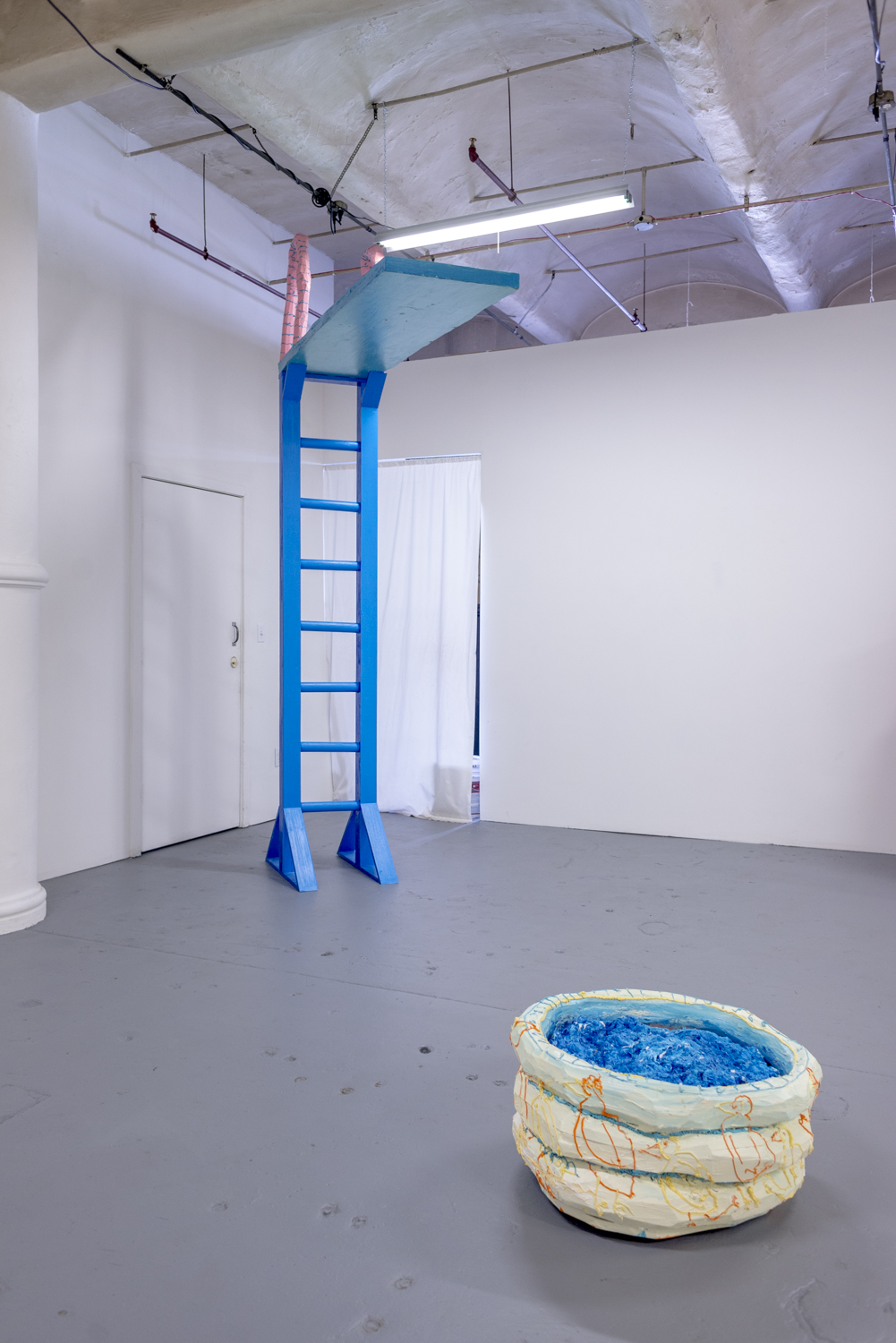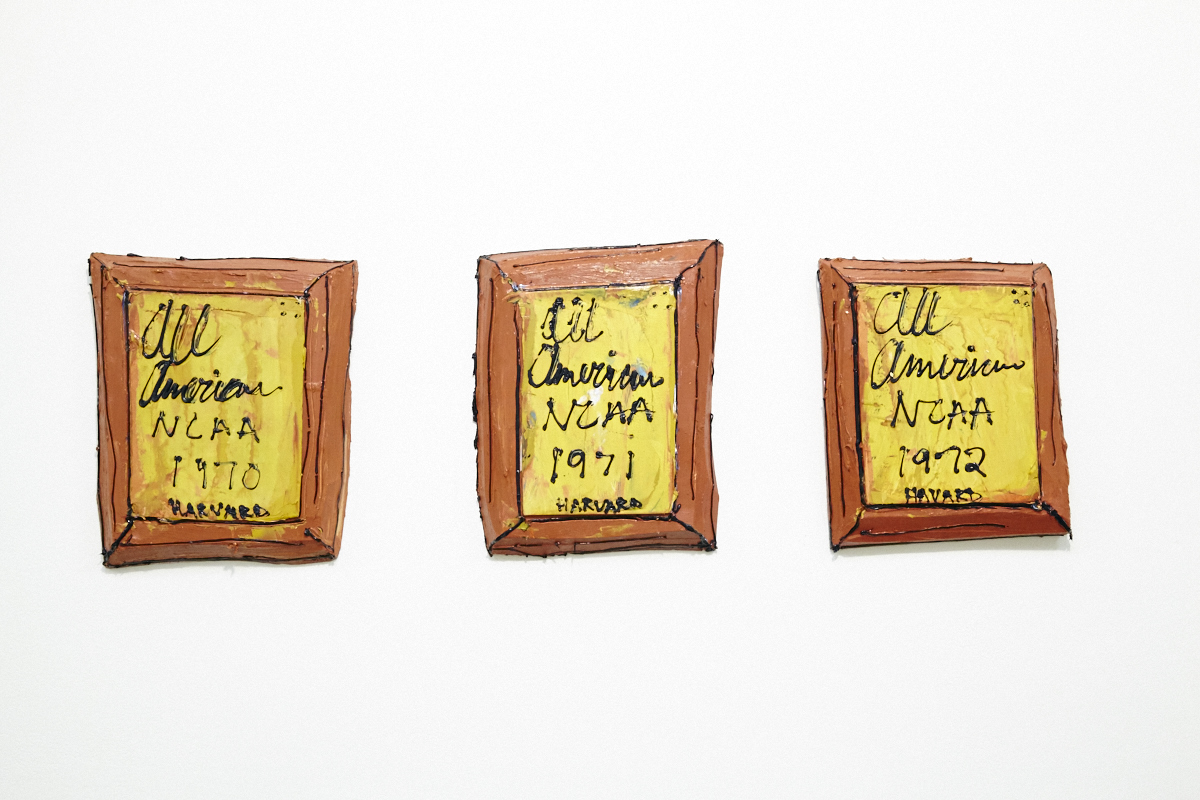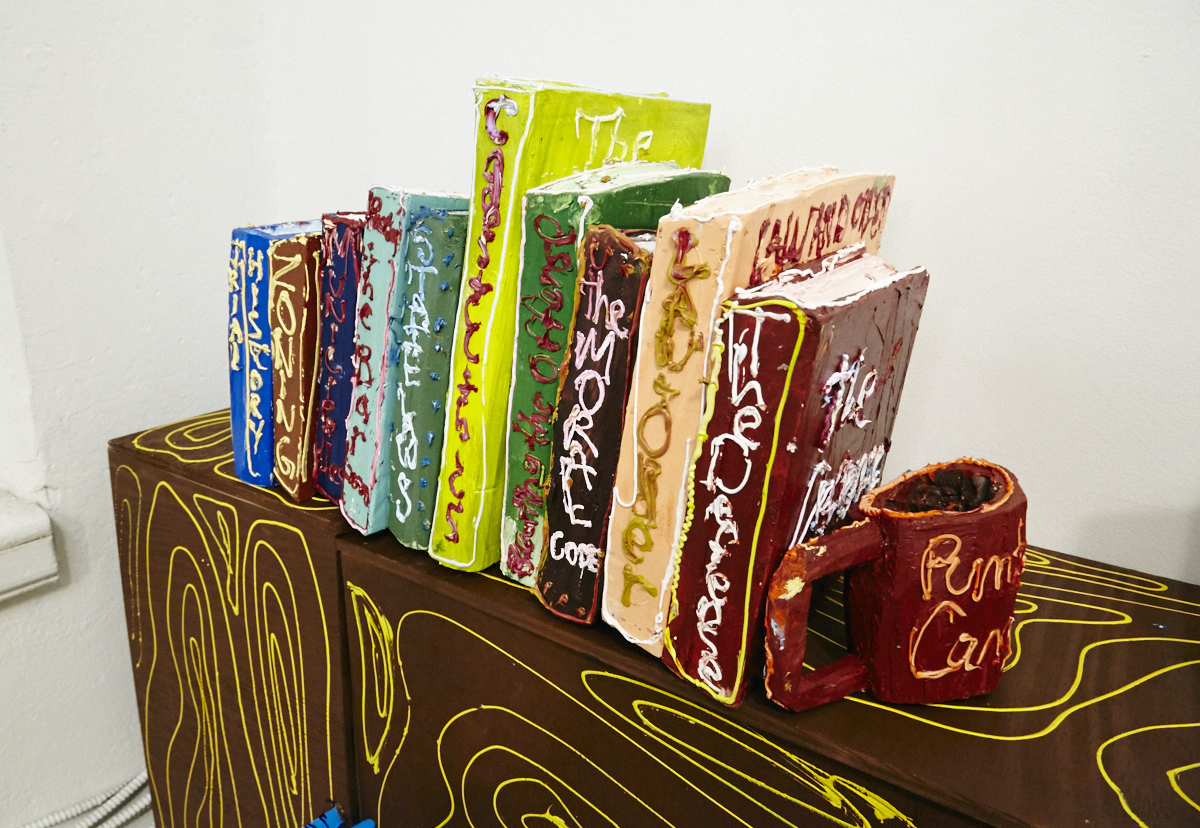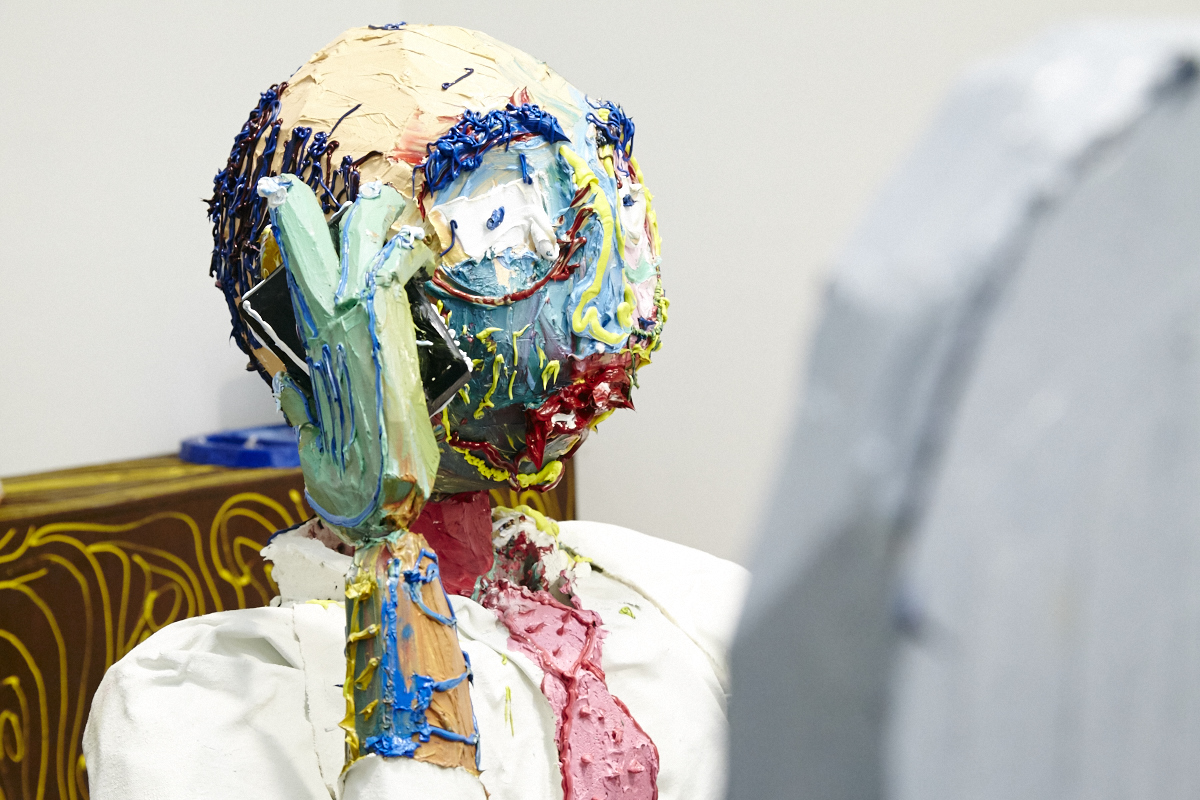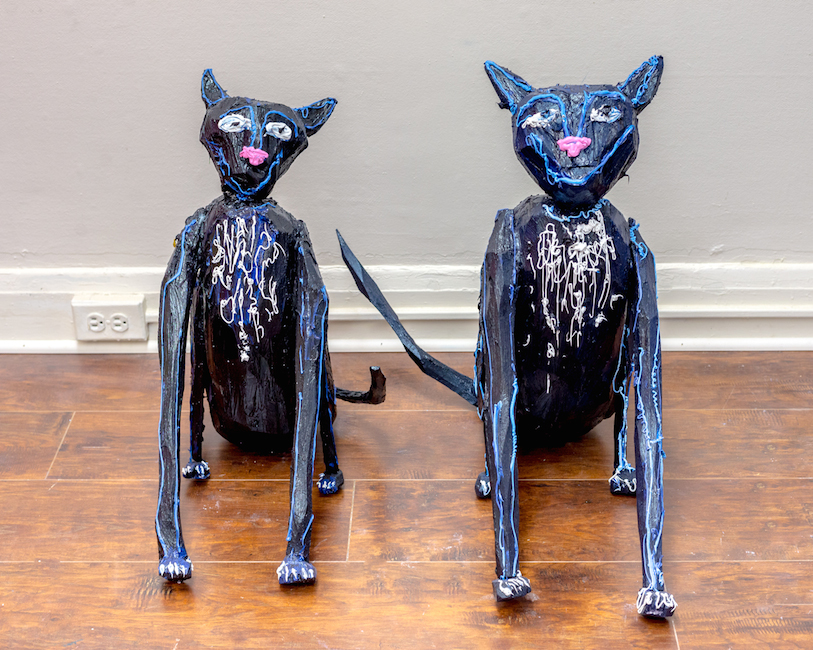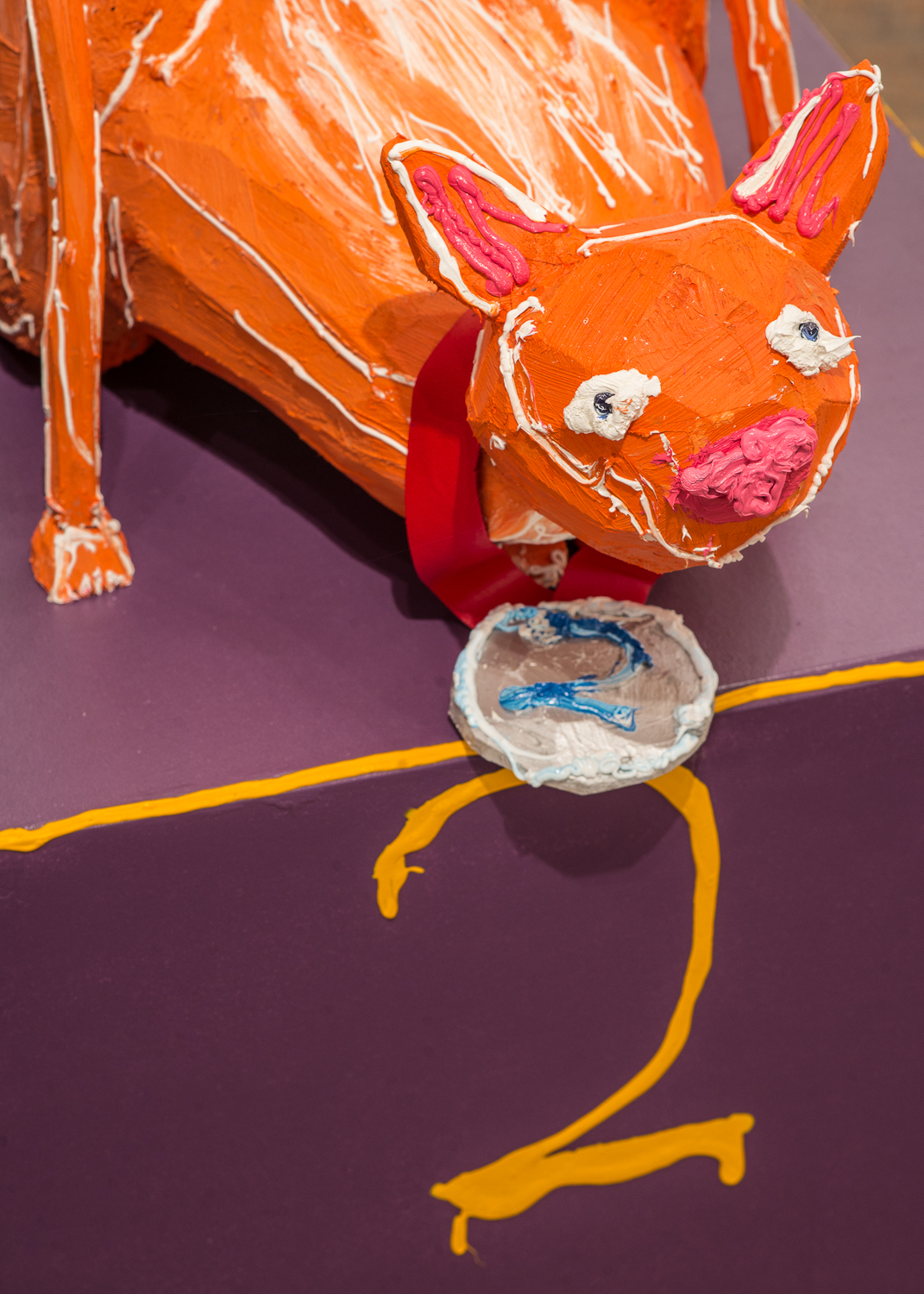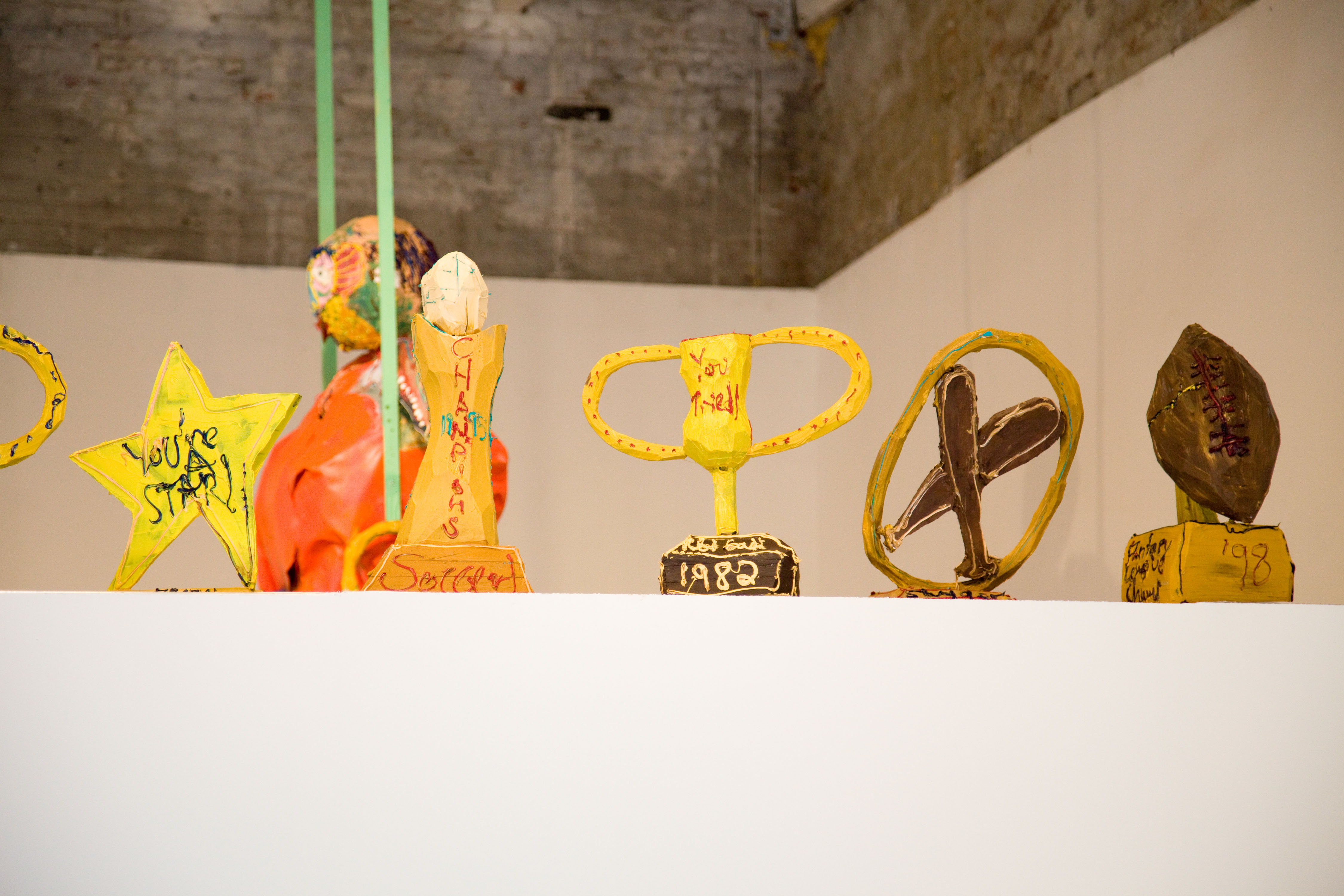About Dave
Baltimore City
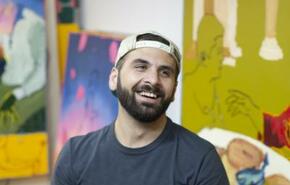
Dave Eassa is a visual artist and cultural worker that investigates relationships, social structures, and memories through painting, sculpture, and in community.
His work explores all the parts of being human; the good, the bad, and the ugly, the things that are sometimes too big to say out loud, sometimes are too quiet to make a noise, and everything in between. His paintings and sculpture simultaneously allow the viewer space for personal reflection and encourage a broader look… more
His work explores all the parts of being human; the good, the bad, and the ugly, the things that are sometimes too big to say out loud, sometimes are too quiet to make a noise, and everything in between. His paintings and sculpture simultaneously allow the viewer space for personal reflection and encourage a broader look… more
Jump to a project:
The Sum of All Parts (Moving Forward)
"The Sum of All Parts (Moving Forward)" pays homage to the past experiences and people that have contributed to where I am today. The mountain references a place that in my formative years became an environment where many coming-of-age experiences occurred. The people and objects all represents individuals or groups of people that were once very much in my life or still play a large role in my life. The process became a very nostalgic way to appreciate what I've had while thinking about where life is going. Materials include wood, dirt, Pink Panther insulating foam, and oil paint.
-
 The Sum of All Parts (Moving Forward)16' x 30' x 18' Installation view. Wood, dirt, Pink Panther insulation foam, and oil paint. 2013.
The Sum of All Parts (Moving Forward)16' x 30' x 18' Installation view. Wood, dirt, Pink Panther insulation foam, and oil paint. 2013. -
 The Sum of All Parts (Moving Forward)16' x 30' x 18' Installation view. Wood, dirt, Pink Panther insulation foam, and oil paint. 2013.
The Sum of All Parts (Moving Forward)16' x 30' x 18' Installation view. Wood, dirt, Pink Panther insulation foam, and oil paint. 2013. -
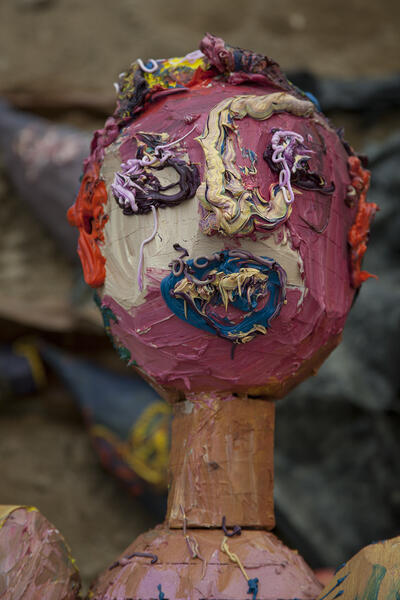 The Sum of All Parts (Moving Forward)16' x 30' x 18' Installation view. Wood, dirt, Pink Panther insulation foam, and oil paint. 2013.
The Sum of All Parts (Moving Forward)16' x 30' x 18' Installation view. Wood, dirt, Pink Panther insulation foam, and oil paint. 2013. -
 The Sum of All Parts (Moving Forward)16' x 30' x 18' Installation view. Wood, dirt, Pink Panther insulation foam, and oil paint. 2013.
The Sum of All Parts (Moving Forward)16' x 30' x 18' Installation view. Wood, dirt, Pink Panther insulation foam, and oil paint. 2013. -
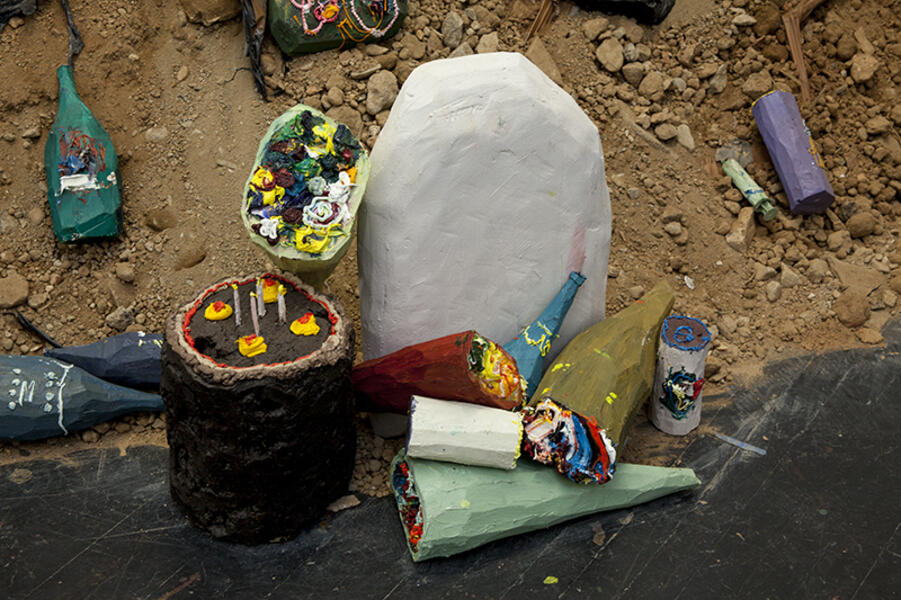 The Sum of All Parts (Moving Forward)16' x 30' x 18' Installation view. Wood, dirt, Pink Panther insulation foam, and oil paint. 2013.
The Sum of All Parts (Moving Forward)16' x 30' x 18' Installation view. Wood, dirt, Pink Panther insulation foam, and oil paint. 2013. -
 The Sum of All Parts (Moving Forward)16' x 30' x 18' Installation view. Wood, dirt, Pink Panther insulation foam, and oil paint. 2013.
The Sum of All Parts (Moving Forward)16' x 30' x 18' Installation view. Wood, dirt, Pink Panther insulation foam, and oil paint. 2013. -
 The Sum of All Parts (Moving Forward)16' x 30' x 18' Installation view. Wood, dirt, Pink Panther insulation foam, and oil paint. 2013.
The Sum of All Parts (Moving Forward)16' x 30' x 18' Installation view. Wood, dirt, Pink Panther insulation foam, and oil paint. 2013. -
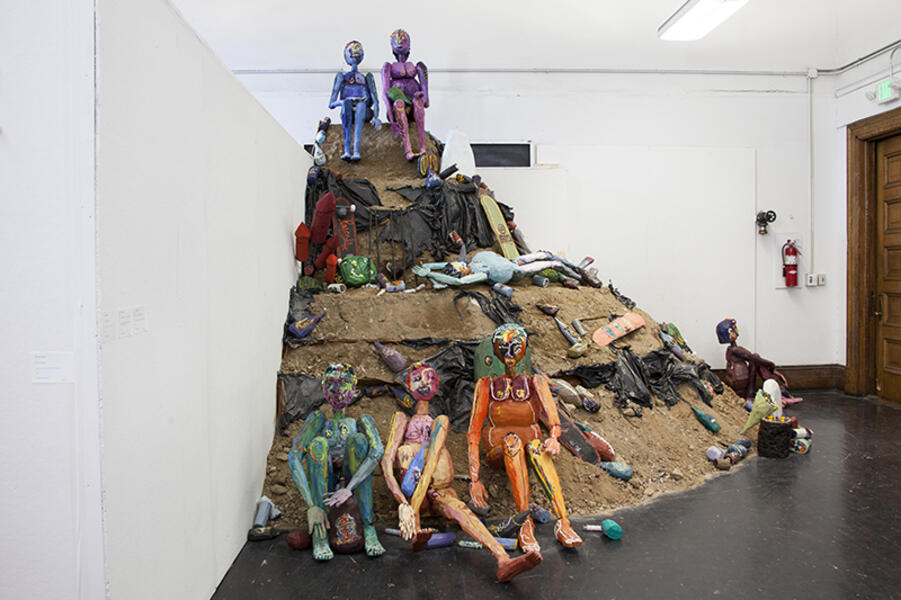 The Sum of All Parts (Moving Forward)16' x 30' x 18' Installation view. Wood, dirt, Pink Panther insulation foam, and oil paint. 2013.
The Sum of All Parts (Moving Forward)16' x 30' x 18' Installation view. Wood, dirt, Pink Panther insulation foam, and oil paint. 2013. -
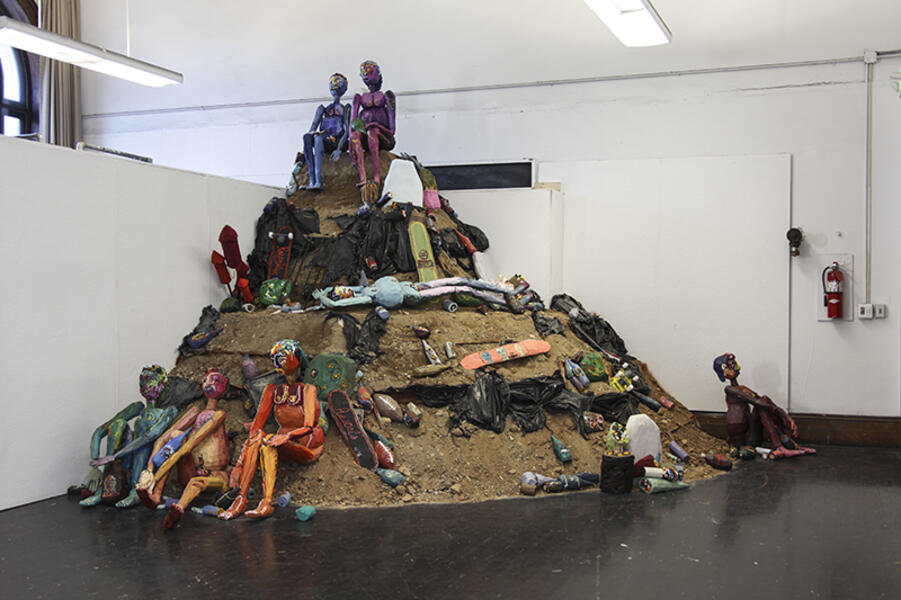 The Sum of All Parts (Moving Forward)16' x 30' x 18' Installation view. Wood, dirt, Pink Panther insulation foam, and oil paint. 2013.
The Sum of All Parts (Moving Forward)16' x 30' x 18' Installation view. Wood, dirt, Pink Panther insulation foam, and oil paint. 2013. -
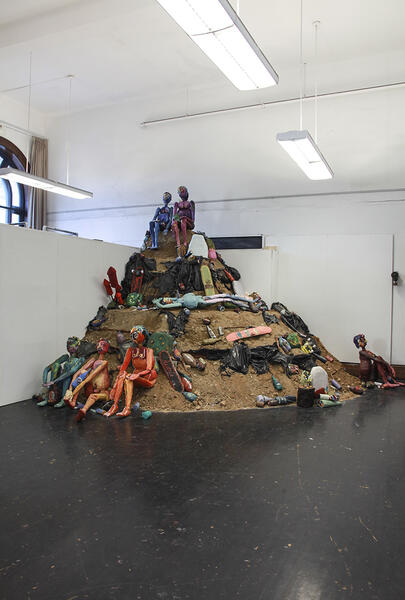 The Sum Of All Parts (Moving Forward)16' x 30' x 18' Installation view. Wood, dirt, Pink Panther insulation foam, and oil paint. 2013.
The Sum Of All Parts (Moving Forward)16' x 30' x 18' Installation view. Wood, dirt, Pink Panther insulation foam, and oil paint. 2013.
"Dreamhouse"
When I was around the age of eight years old, I really thought I had it figured out. Bite the bullet and live with my parents for ten more painful years and then I was going to buy my own house to live in and I would never have to listen to rules again. My idea around then about what my life was going to be like was very different than the way things ended up. I idolized Michael Jordan, heavily because of watching Space Jam, and was sure I would be a professional basketball player when I grew up. I always knew I wanted a Coca-cola water fountain, and my own jacuzzi, no other option. I loved diving boards, and decided I should have my own pool. In my mind, I was creating my future dreamhouse which seemed more than reasonable to obtain.
-
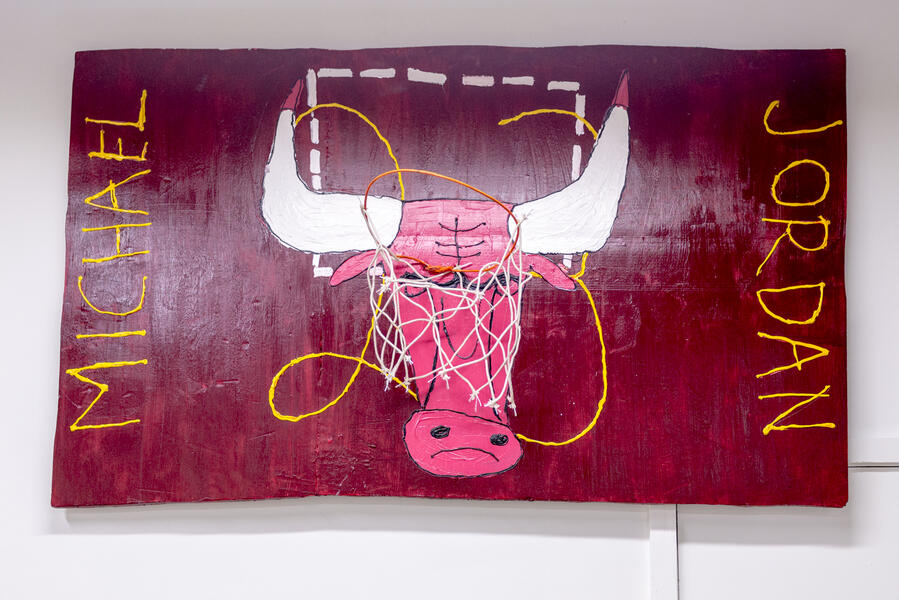 Space Jam Basketball CourtDimensions variable, detail image. Hardwood flooring, Pink Panther insulation foam, acrylic and oil paint. 2014
Space Jam Basketball CourtDimensions variable, detail image. Hardwood flooring, Pink Panther insulation foam, acrylic and oil paint. 2014 -
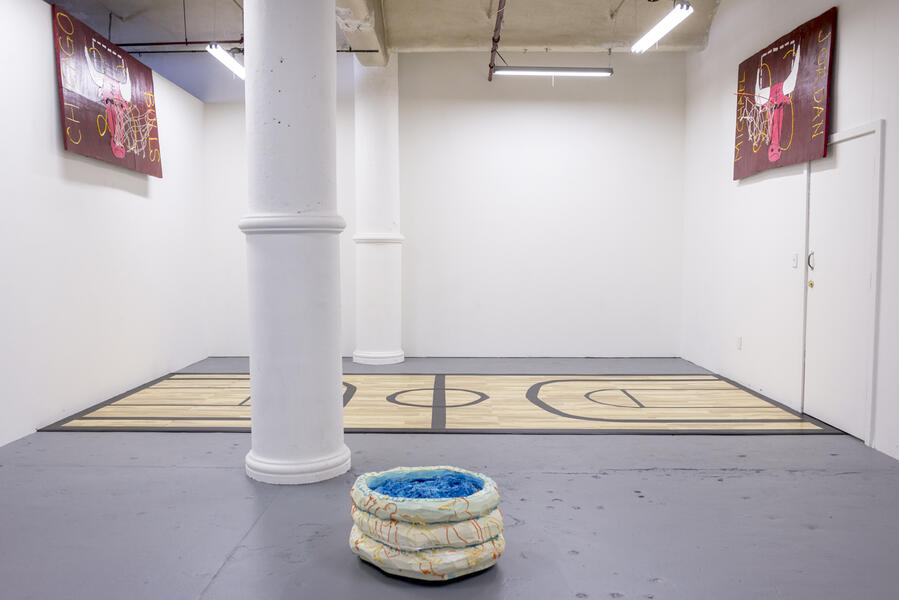 DreamhouseDimensions variable, Installation view. Hardwood flooring, Pink Panther insulation foam, wood, acrylic and oil paint. 2014
DreamhouseDimensions variable, Installation view. Hardwood flooring, Pink Panther insulation foam, wood, acrylic and oil paint. 2014 -
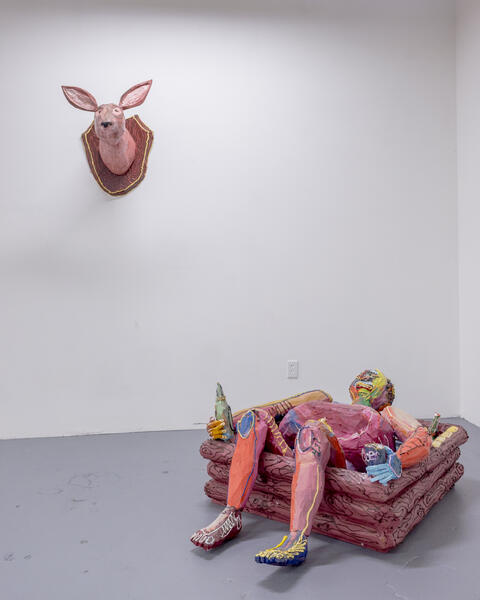 DreamhouseDimensions variable, Installation view. Hardwood flooring, Pink Panther insulation foam, wood, acrylic and oil paint. 2014
DreamhouseDimensions variable, Installation view. Hardwood flooring, Pink Panther insulation foam, wood, acrylic and oil paint. 2014 -
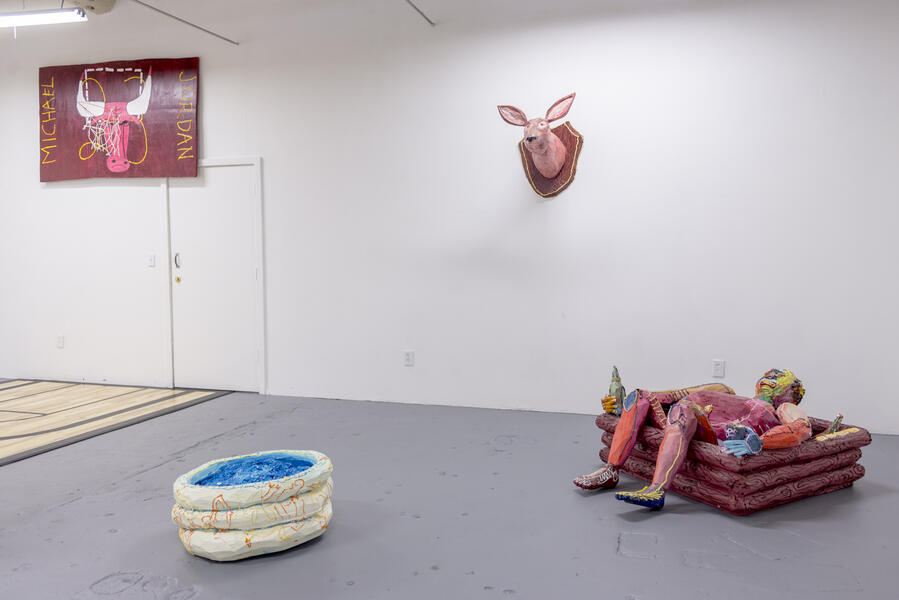 DreamhouseDimensions variable, Installation view. Hardwood flooring, Pink Panther insulation foam, wood, acrylic and oil paint. 2014
DreamhouseDimensions variable, Installation view. Hardwood flooring, Pink Panther insulation foam, wood, acrylic and oil paint. 2014 -
 DreamhouseDimensions variable, Installation view. Hardwood flooring, Pink Panther insulation foam, wood, acrylic and oil paint. 2014
DreamhouseDimensions variable, Installation view. Hardwood flooring, Pink Panther insulation foam, wood, acrylic and oil paint. 2014 -
 High DiveDimensions variable, Installation view. Pink Panther insulation foam, wood, acrylic and oil paint. 2014
High DiveDimensions variable, Installation view. Pink Panther insulation foam, wood, acrylic and oil paint. 2014 -
 My Best Friend's Father Was A Hunter38" x 18" x 28" Pink Panther insulation foam and oil paint. 2014
My Best Friend's Father Was A Hunter38" x 18" x 28" Pink Panther insulation foam and oil paint. 2014 -
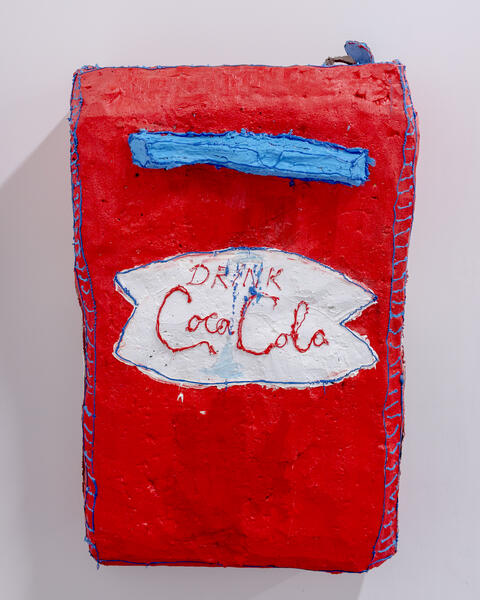 Coca-Cola Water Fountain40" x 30" x 24" Pink Panther insulation foam and oil paint. 2014
Coca-Cola Water Fountain40" x 30" x 24" Pink Panther insulation foam and oil paint. 2014 -
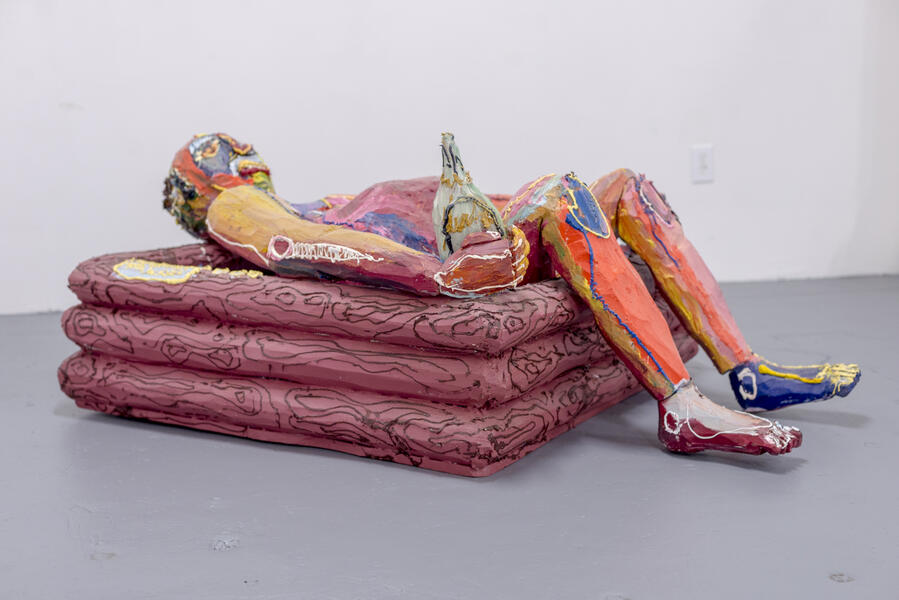 My Own Mahogany Jacuzzi25" x 50" x 54" Pink Panther insulation foam and oil paint, 2014.
My Own Mahogany Jacuzzi25" x 50" x 54" Pink Panther insulation foam and oil paint, 2014. -
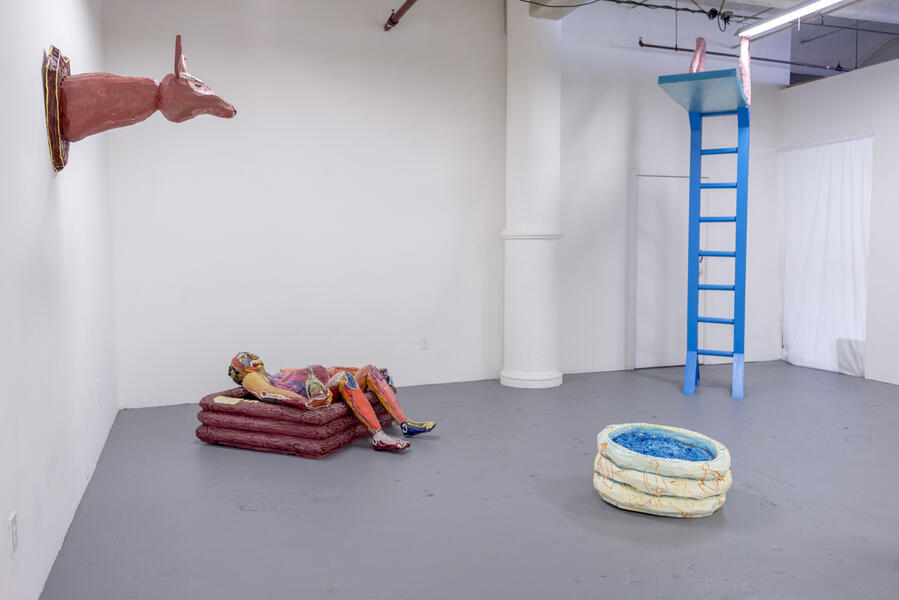 DreamhouseDimensions variable, Installation view. Hardwood flooring, Pink Panther insulation foam, wood, acrylic and oil paint. 2014
DreamhouseDimensions variable, Installation view. Hardwood flooring, Pink Panther insulation foam, wood, acrylic and oil paint. 2014
Paintings 2013-2015
-
 Beating the Odds48" x 48", Oil on canvas, 2015.
Beating the Odds48" x 48", Oil on canvas, 2015. -
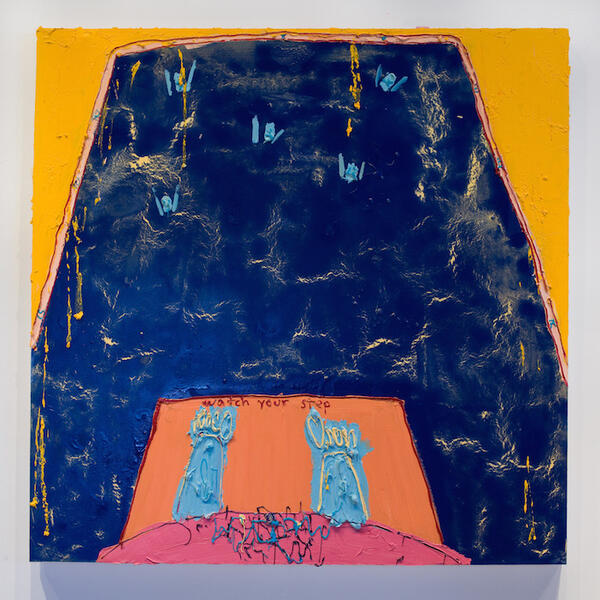 High Dive48" x 48" Oil and Elmer's glue on canvas. 2015
High Dive48" x 48" Oil and Elmer's glue on canvas. 2015 -
 Going Through the Motions (Yellow)12" x 9", Spraypaint, oil and Elmer's glue on canvas, 2014.
Going Through the Motions (Yellow)12" x 9", Spraypaint, oil and Elmer's glue on canvas, 2014. -
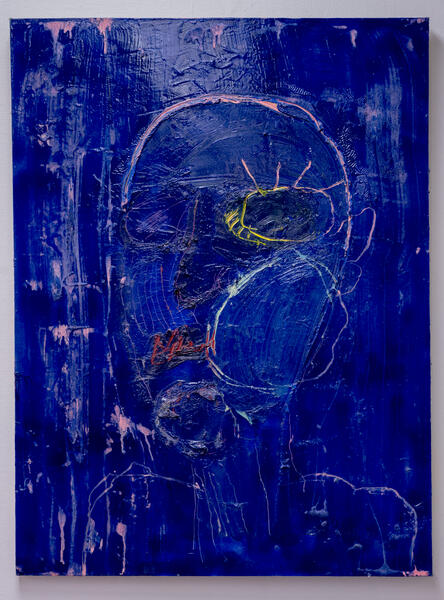 Going Through the Motions (Blue)40" x 30" Spraypaint and oil on canvas, 2014.
Going Through the Motions (Blue)40" x 30" Spraypaint and oil on canvas, 2014. -
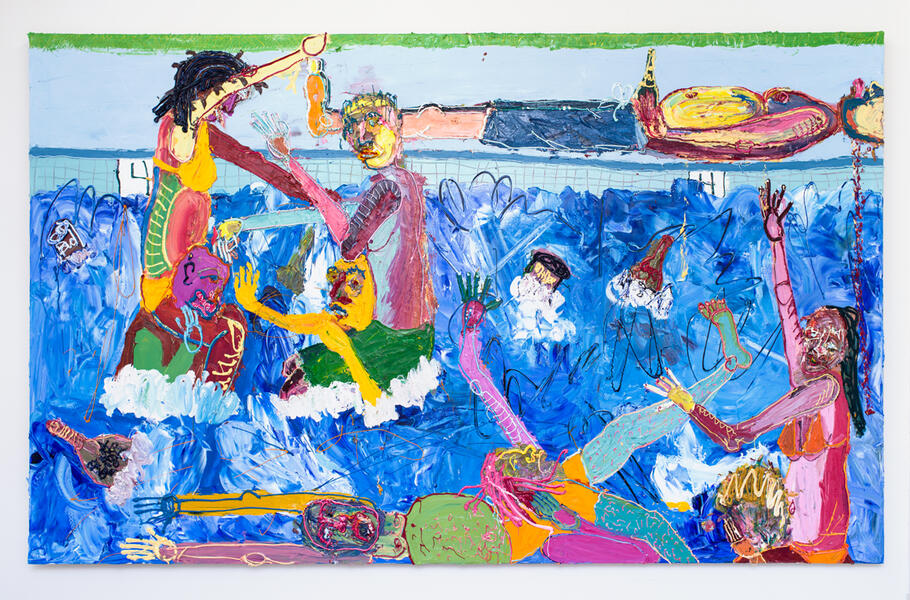 Pool Party60" x 98", Oil on canvas, 2014.
Pool Party60" x 98", Oil on canvas, 2014. -
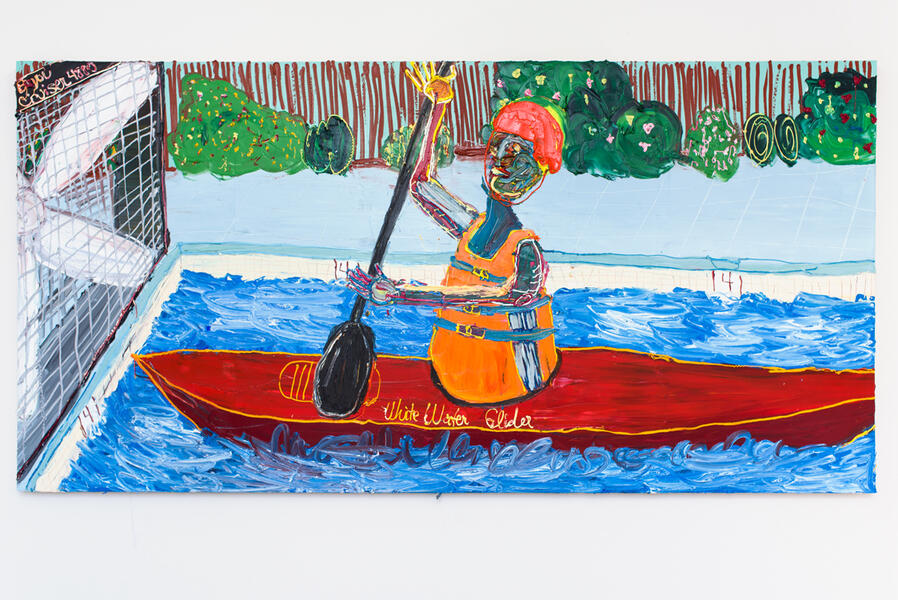 Olympic Development48" x 96", Oil on canvas, 2014.
Olympic Development48" x 96", Oil on canvas, 2014. -
 Dad Time48" x 72", Oil on canvas, 2014.
Dad Time48" x 72", Oil on canvas, 2014. -
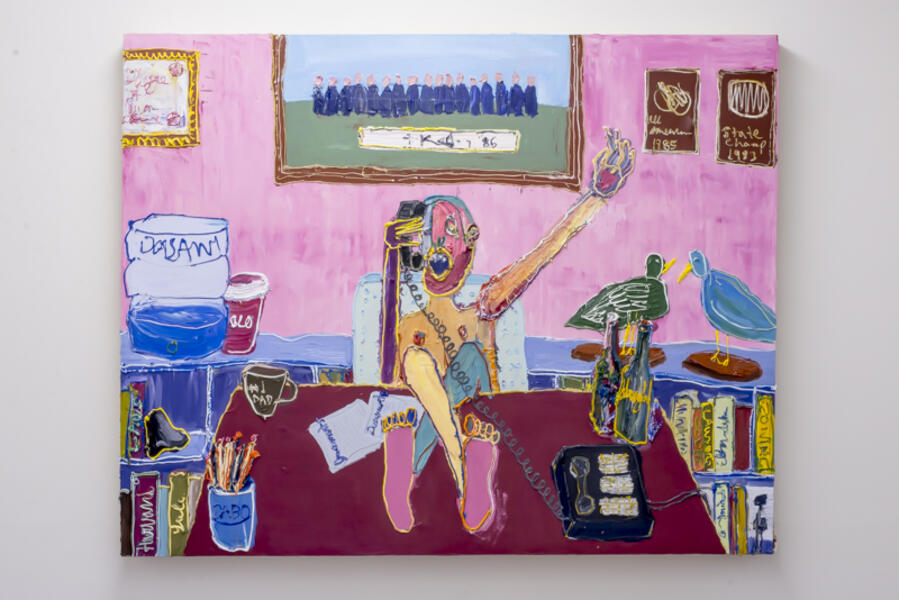 My Mother Always Told Me I'd Grow To Be A Lawyer48" x 60", Oil on canvas, 2013.
My Mother Always Told Me I'd Grow To Be A Lawyer48" x 60", Oil on canvas, 2013. -
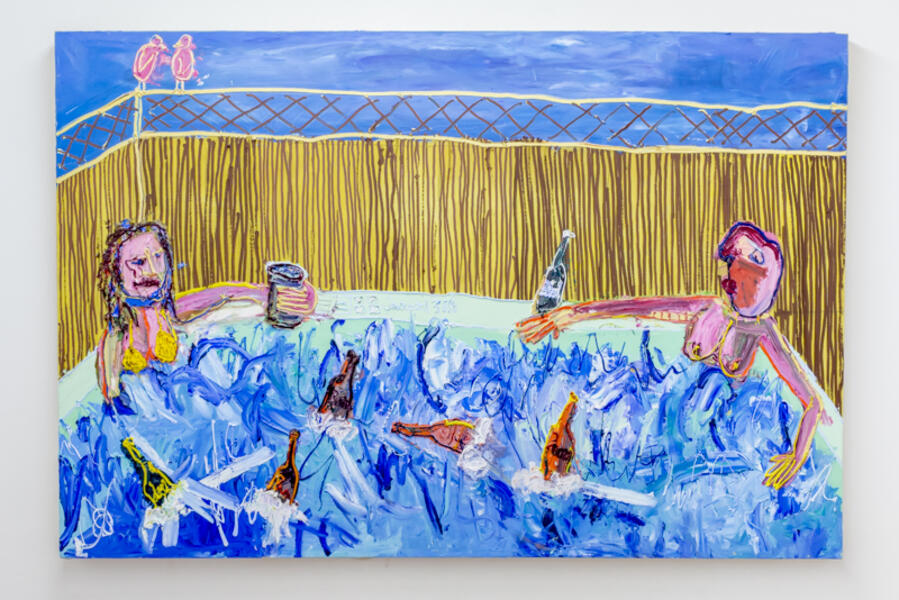 Love Birds48" x 72", Oil on canvas, 2013.
Love Birds48" x 72", Oil on canvas, 2013. -
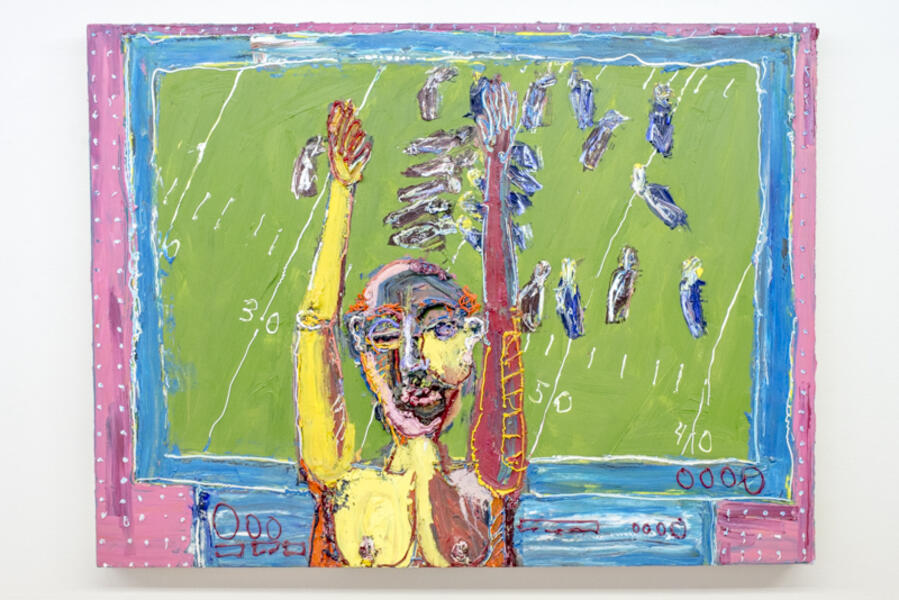 Every Sunday36" x 48", Oil on canvas, 2013.
Every Sunday36" x 48", Oil on canvas, 2013.
My Mother Always Told Me I'd Grow Up To Be A Lawyer
What do you do?
What’s your five year plan? Ten year? Retirement?
Maybe if you are lucky you will end up a rich man with a beautiful wife.
This installation imagines and builds a high profile lawyer's from the artist's stereotyped and preconceived ideas. The installation questions societal constructs and pressures surrounding Ivy League Culture, family dynasty,privilege, 9 to 5 job security, monetary and material milestones, self critique, and teenage and childhood nostalgia amongst others.
What’s your five year plan? Ten year? Retirement?
Maybe if you are lucky you will end up a rich man with a beautiful wife.
This installation imagines and builds a high profile lawyer's from the artist's stereotyped and preconceived ideas. The installation questions societal constructs and pressures surrounding Ivy League Culture, family dynasty,privilege, 9 to 5 job security, monetary and material milestones, self critique, and teenage and childhood nostalgia amongst others.
-
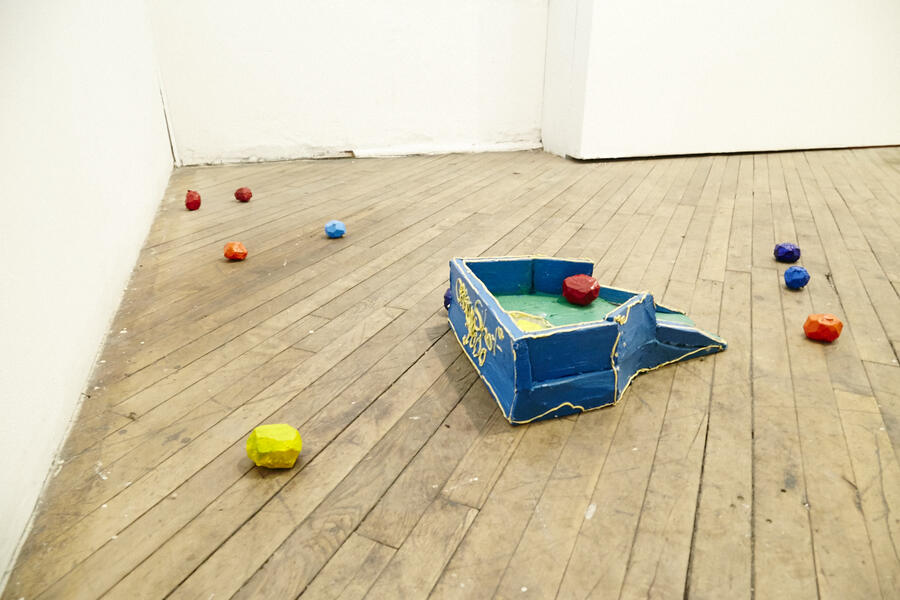 My Mother Always Told Me I'd Grow Up To Be A LawyerDimensions variable, Installation view. Plaster, plywood, Pink Panther insulation foam, acrylic and oil paint. 2015
My Mother Always Told Me I'd Grow Up To Be A LawyerDimensions variable, Installation view. Plaster, plywood, Pink Panther insulation foam, acrylic and oil paint. 2015 -
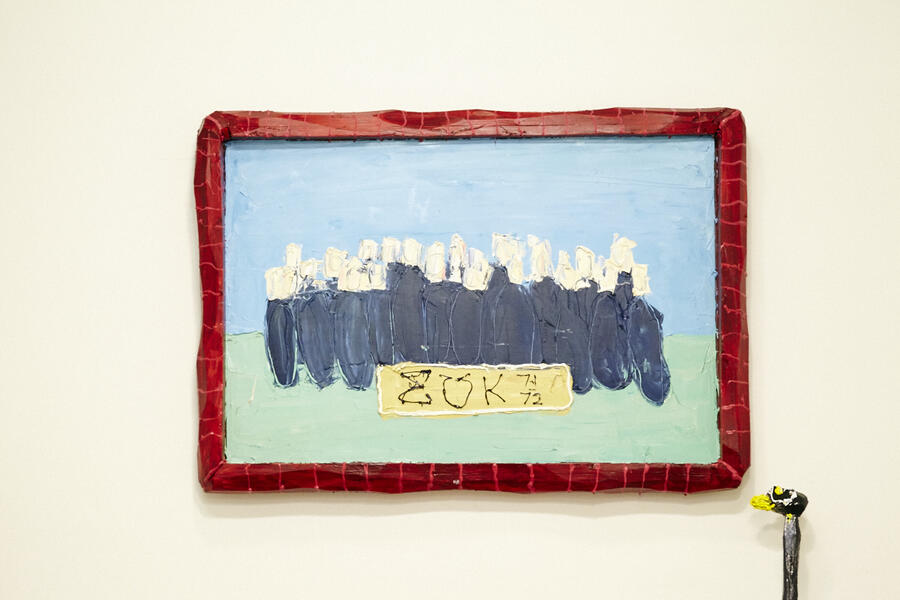 My Mother Always Told Me I'd Grow Up To Be A LawyerDimensions variable, Installation view. Plaster, plywood, Pink Panther insulation foam, acrylic and oil paint. 2015
My Mother Always Told Me I'd Grow Up To Be A LawyerDimensions variable, Installation view. Plaster, plywood, Pink Panther insulation foam, acrylic and oil paint. 2015 -
 My Mother Always Told Me I'd Grow Up To Be A LawyerDimensions variable, Installation view. Plaster, plywood, Pink Panther insulation foam, acrylic and oil paint. 2015
My Mother Always Told Me I'd Grow Up To Be A LawyerDimensions variable, Installation view. Plaster, plywood, Pink Panther insulation foam, acrylic and oil paint. 2015 -
 My Mother Always Told Me I'd Grow Up To Be A LawyerDimensions variable, Installation view. Plaster, plywood, Pink Panther insulation foam, acrylic and oil paint. 2015
My Mother Always Told Me I'd Grow Up To Be A LawyerDimensions variable, Installation view. Plaster, plywood, Pink Panther insulation foam, acrylic and oil paint. 2015 -
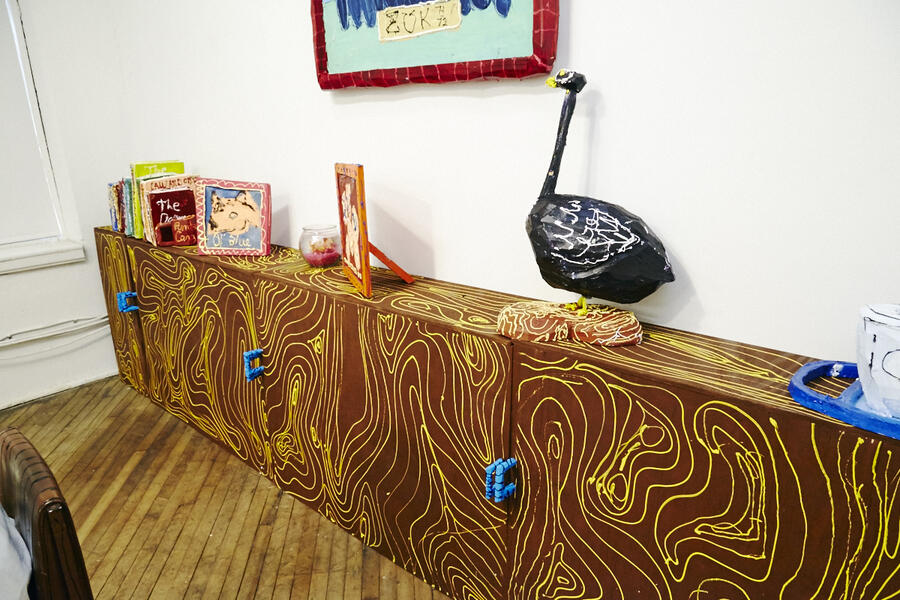 My Mother Always Told Me I'd Grow Up To Be A LawyerDimensions variable, Installation view. Plaster, plywood, Pink Panther insulation foam, acrylic and oil paint. 2015
My Mother Always Told Me I'd Grow Up To Be A LawyerDimensions variable, Installation view. Plaster, plywood, Pink Panther insulation foam, acrylic and oil paint. 2015 -
 Bro. George Thompson on GuitarPhoto by Sean Scheidt
Bro. George Thompson on GuitarPhoto by Sean Scheidt -
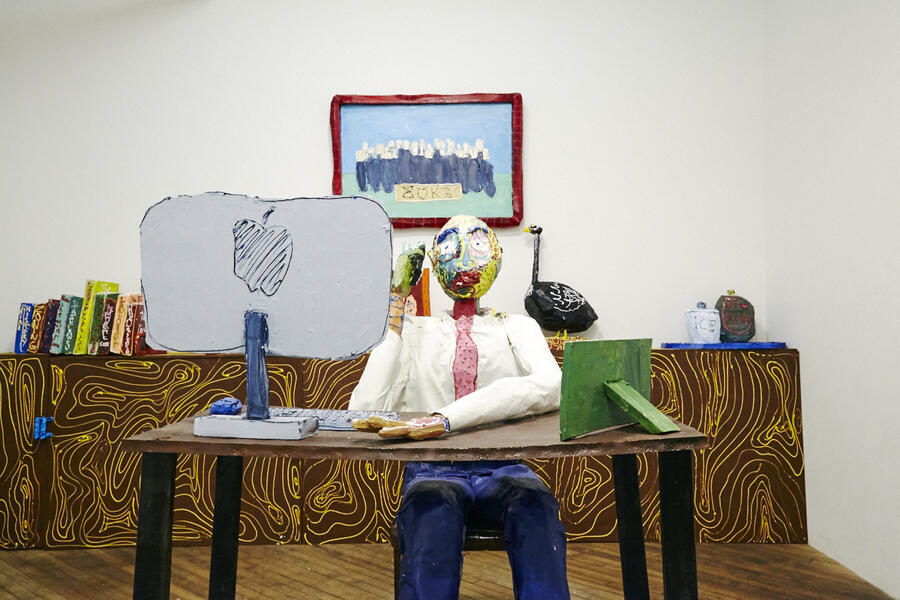 My Mother Always Told Me I'd Grow Up To Be A LawyerDimensions variable, Installation view. Plaster, plywood, Pink Panther insulation foam, acrylic and oil paint. 2015
My Mother Always Told Me I'd Grow Up To Be A LawyerDimensions variable, Installation view. Plaster, plywood, Pink Panther insulation foam, acrylic and oil paint. 2015 -
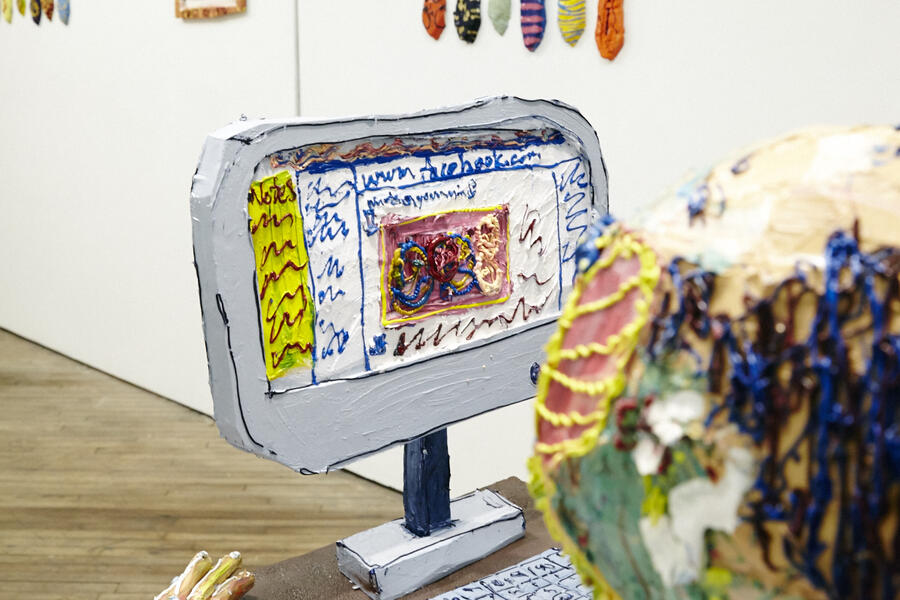 My Mother Always Told Me I'd Grow Up To Be A LawyerDimensions variable, Installation view. Plaster, plywood, Pink Panther insulation foam, acrylic and oil paint. 2015
My Mother Always Told Me I'd Grow Up To Be A LawyerDimensions variable, Installation view. Plaster, plywood, Pink Panther insulation foam, acrylic and oil paint. 2015 -
 My Mother Always Told Me I'd Grow Up To Be A LawyerDimensions variable, Installation view. Plaster, plywood, Pink Panther insulation foam, acrylic and oil paint. 2015
My Mother Always Told Me I'd Grow Up To Be A LawyerDimensions variable, Installation view. Plaster, plywood, Pink Panther insulation foam, acrylic and oil paint. 2015 -
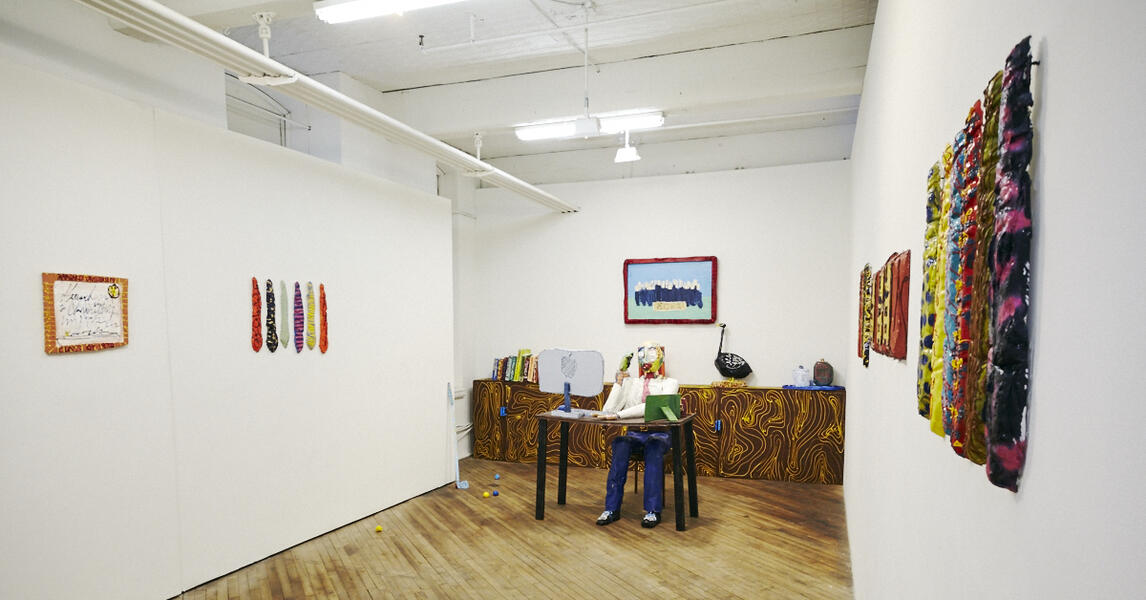 My Mother Always Told Me I'd Grow Up To Be A LawyerDimensions variable, Installation view. Plaster, plywood, Pink Panther insulation foam, acrylic and oil paint. 2015
My Mother Always Told Me I'd Grow Up To Be A LawyerDimensions variable, Installation view. Plaster, plywood, Pink Panther insulation foam, acrylic and oil paint. 2015
The Kickapoo
The Kickapoo was an experimental classroom and gallery space that I opened in Stueben, WI while an artist in residence at ACRE in August 2015. When fellow residents, staff and visiting artists/curators were invited to sign up for drawing classes they were provided with no other information than to bring a bathing suit. Two types of classes were offered, still-life and portraiture. Students were encouraged to explore the medium of drawing while tubing down the river on specially configured tube rafts. Classes lasted approximately 30 minutes while I guided the floating classroom safely around the rocks and sticks of the Kickapoo. The project culminated with an opening exhibition of student work displayed along the river on Thursday August 13th, 2015.
-
 The KickapooStill life class.
The KickapooStill life class. -
 The KickapooOpening reception highlighting student work.
The KickapooOpening reception highlighting student work. -
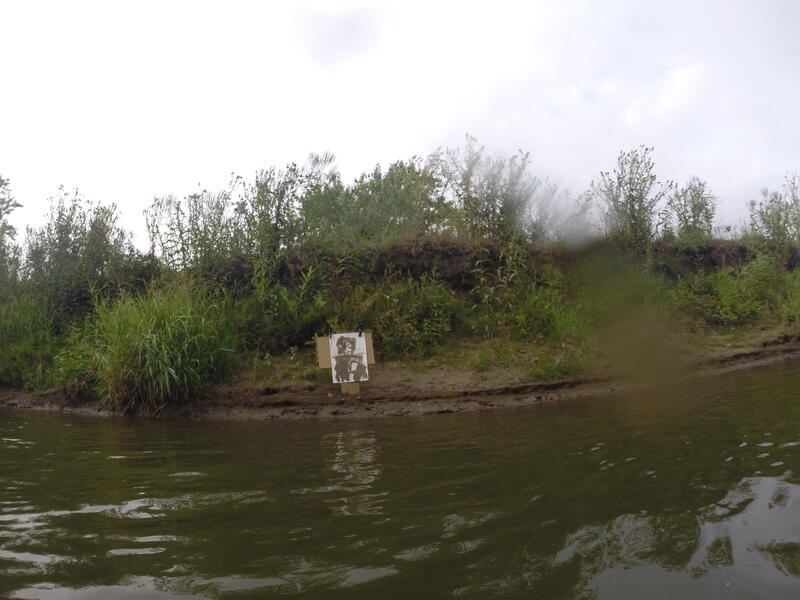 The KickapooExhibition installation view, work by Mark McCloughan pictured.
The KickapooExhibition installation view, work by Mark McCloughan pictured. -
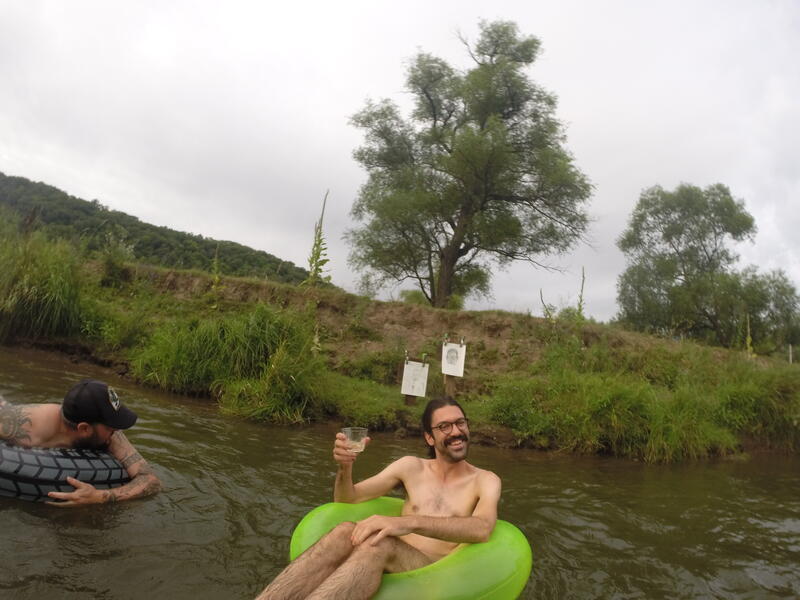 The KickapooOpening reception highlighting student work.
The KickapooOpening reception highlighting student work. -
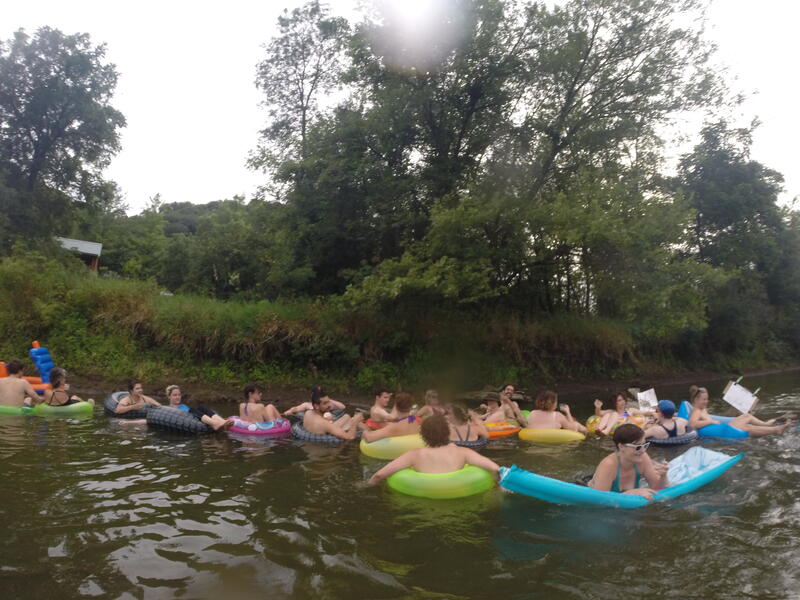 The KickapooOpening reception highlighting student work.
The KickapooOpening reception highlighting student work. -
 The KickapooPortrait class.
The KickapooPortrait class. -
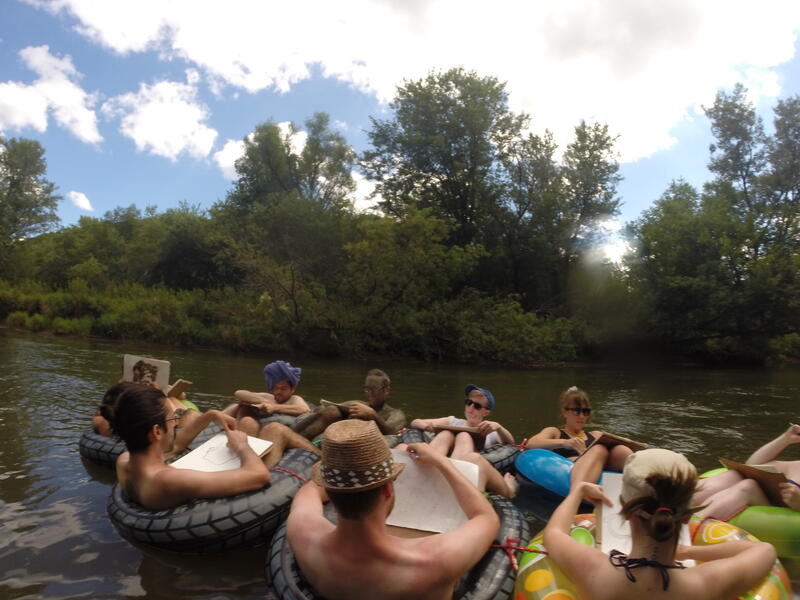 The KickapooPortrait Class.
The KickapooPortrait Class. -
 The KickapooStill life class.
The KickapooStill life class. -
 The KickapooStill-life class.
The KickapooStill-life class. -
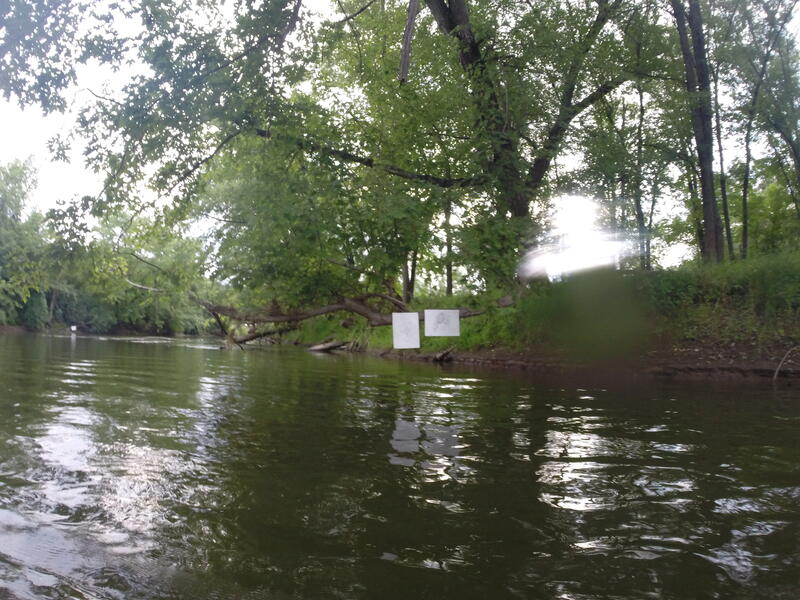 The KickapooExhibition installation view, work by Willy Smart and Jim Drain pictured.
The KickapooExhibition installation view, work by Willy Smart and Jim Drain pictured.
Advanced Cats
-
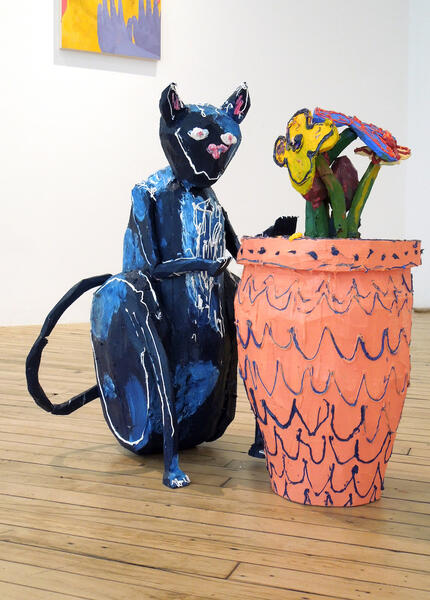 Hand In The Cookie Jar36" x 22" x 40" Pink Panther insulation foam and oil paint. 2015
Hand In The Cookie Jar36" x 22" x 40" Pink Panther insulation foam and oil paint. 2015 -
 Guardians of the Bad Luck36" x 16" x 30" each, Pink Panther insulation foam and oil paint.
Guardians of the Bad Luck36" x 16" x 30" each, Pink Panther insulation foam and oil paint. -
 A Strong Hold On One's Self ImagePink Panther insulation foam, canvas, and oil paint. Canvas: 55" x 50" Cat: 15" x 18" x 30" 2016
A Strong Hold On One's Self ImagePink Panther insulation foam, canvas, and oil paint. Canvas: 55" x 50" Cat: 15" x 18" x 30" 2016 -
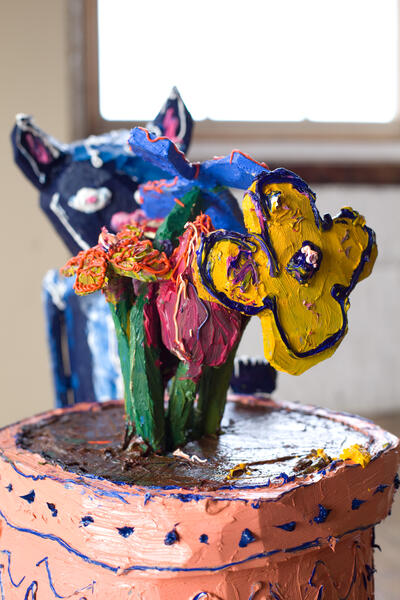 Hand in the Cookie Jar (detail)36" x 22" x 40" Pink Panther insulation foam and oil paint. 2015
Hand in the Cookie Jar (detail)36" x 22" x 40" Pink Panther insulation foam and oil paint. 2015 -
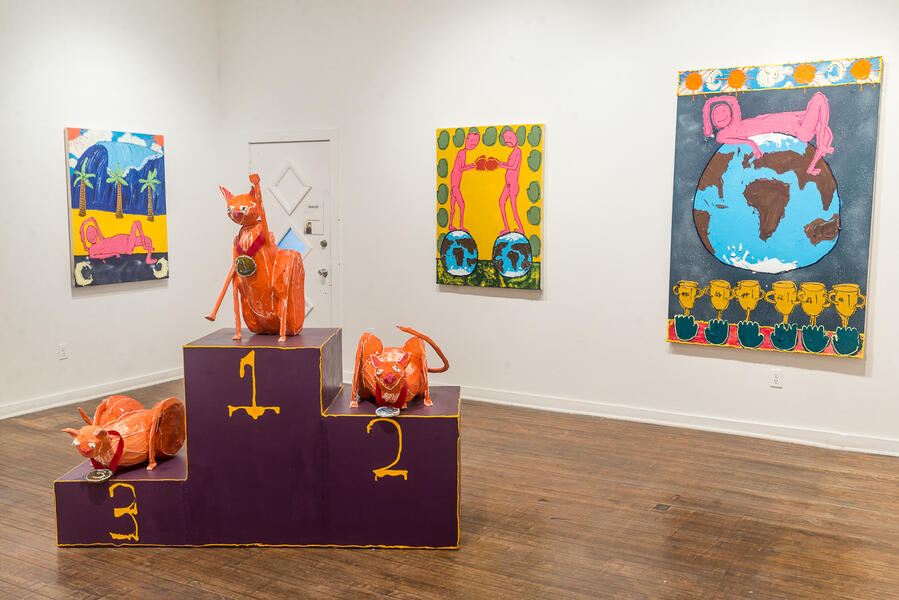 Going for Gold (Who Really Wins Anyways?)Pink Panther insulation foam, wood, canvas, acrylic, latex, and oil paint. 65” x 72” x 24” 2017.
Going for Gold (Who Really Wins Anyways?)Pink Panther insulation foam, wood, canvas, acrylic, latex, and oil paint. 65” x 72” x 24” 2017. -
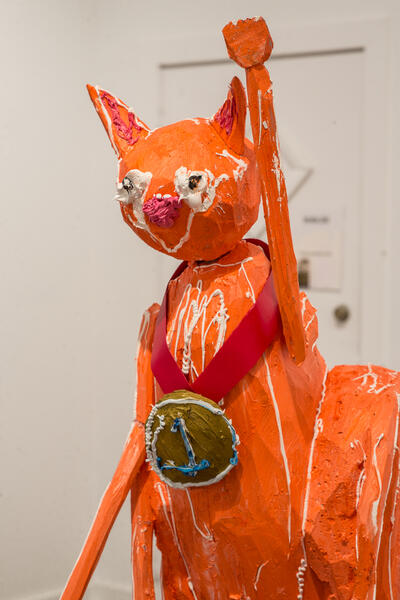 Going for Gold (Who Really Wins Anyways?)Pink Panther insulation foam, wood, canvas, acrylic, latex, and oil paint. 65” x 72” x 24” 2017.
Going for Gold (Who Really Wins Anyways?)Pink Panther insulation foam, wood, canvas, acrylic, latex, and oil paint. 65” x 72” x 24” 2017. -
 Going for Gold (Who Really Wins Anyways?)Pink Panther insulation foam, wood, canvas, acrylic, latex, and oil paint. 65” x 72” x 24” 2017.
Going for Gold (Who Really Wins Anyways?)Pink Panther insulation foam, wood, canvas, acrylic, latex, and oil paint. 65” x 72” x 24” 2017.
Free Space
“Free Space” is a artist led program that creates a safe space for incarcerated individuals in the Maryland Prison system through art classes rooted in visual and written arts, stressing individual and collaborative growth while breaking down boundaries between the participants.
Since January 2015, Free Space has held programming at the Maryland Correctional Institution in Jessup weekly. In November of 2015, Free Space began programming at the Maryland Correctional Institution for Women as well as Dorsey Run Correctional Facility. Free Space utilizes artistic exercises, a historical and contemporary investigation into art, and arts based articles and essays to open the doors into the world of art for individuals participating in the program. In addition to weekly classes, Free Space creates publications and mounts exhibitions that bring the art work created by participants to the greater public. Complementing the weekly classes, the Visiting Artist program invites established artists to teach short workshops in an area of their expertise in the way that they see fit. The goal is to expose participants to as many different ideas and ways of making art as possible. Past visiting artists include Jordan Bernier, Peter Ferguson, and Lady Brion.
Free Space was founded by Dave Eassa in 2015.
Since January 2015, Free Space has held programming at the Maryland Correctional Institution in Jessup weekly. In November of 2015, Free Space began programming at the Maryland Correctional Institution for Women as well as Dorsey Run Correctional Facility. Free Space utilizes artistic exercises, a historical and contemporary investigation into art, and arts based articles and essays to open the doors into the world of art for individuals participating in the program. In addition to weekly classes, Free Space creates publications and mounts exhibitions that bring the art work created by participants to the greater public. Complementing the weekly classes, the Visiting Artist program invites established artists to teach short workshops in an area of their expertise in the way that they see fit. The goal is to expose participants to as many different ideas and ways of making art as possible. Past visiting artists include Jordan Bernier, Peter Ferguson, and Lady Brion.
Free Space was founded by Dave Eassa in 2015.
-
Free SpaceThis is an image of an individual who is a participant of Free Space and also currently incarcerated at the Maryland Correctional Institution for Women. This was taken during the early stages of the class while we working on introductory drawing techniques. The classes begin by introducing participants to a variety of art making techniques from drawing with charcoal, graphite, and pastels to painting with watercolor and acrylic. Once we would cover most techniques, the class would become a self-directed studio class with myself being able to offer individual support in each artist's work.
-
 Free SpaceThe classes begin by introducing participants to a variety of art making techniques from drawing with charcoal, graphite, and pastels to painting with watercolor and acrylic. Once we would cover most techniques, the class would become a self-directed studio class with myself being able to offer individual support in each artist's work. This painting was created by Juan at the Maryland Correctional Institution in Jessup. Because of the setting of the classes only the artist's first names can be used.
Free SpaceThe classes begin by introducing participants to a variety of art making techniques from drawing with charcoal, graphite, and pastels to painting with watercolor and acrylic. Once we would cover most techniques, the class would become a self-directed studio class with myself being able to offer individual support in each artist's work. This painting was created by Juan at the Maryland Correctional Institution in Jessup. Because of the setting of the classes only the artist's first names can be used. -
 Free SpaceThe classes begin by introducing participants to a variety of art making techniques from drawing with charcoal, graphite, and pastels to painting with watercolor and acrylic. Once we would cover most techniques, the class would become a self-directed studio class with myself being able to offer individual support in each artist's work. This painting was created by Waymond at the Maryland Correctional Institution in Jessup. Because of the setting of the classes only the artist's first names can be used.
Free SpaceThe classes begin by introducing participants to a variety of art making techniques from drawing with charcoal, graphite, and pastels to painting with watercolor and acrylic. Once we would cover most techniques, the class would become a self-directed studio class with myself being able to offer individual support in each artist's work. This painting was created by Waymond at the Maryland Correctional Institution in Jessup. Because of the setting of the classes only the artist's first names can be used. -
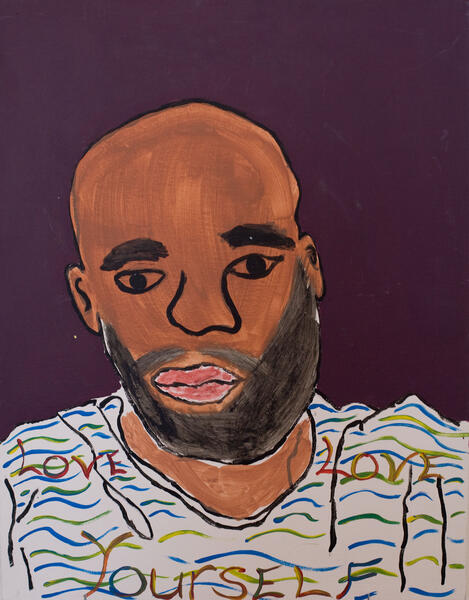 Free SpaceThe classes begin by introducing participants to a variety of art making techniques from drawing with charcoal, graphite, and pastels to painting with watercolor and acrylic. Once we would cover most techniques, the class would become a self-directed studio class with myself being able to offer individual support in each artist's work. This painting was created by Gerald at the Maryland Correctional Institution in Jessup. Because of the setting of the classes only the artist's first names can be used.
Free SpaceThe classes begin by introducing participants to a variety of art making techniques from drawing with charcoal, graphite, and pastels to painting with watercolor and acrylic. Once we would cover most techniques, the class would become a self-directed studio class with myself being able to offer individual support in each artist's work. This painting was created by Gerald at the Maryland Correctional Institution in Jessup. Because of the setting of the classes only the artist's first names can be used. -
 Free SpaceThe classes begin by introducing participants to a variety of art making techniques from drawing with charcoal, graphite, and pastels to painting with watercolor and acrylic. Once we would cover most techniques, the class would become a self-directed studio class with myself being able to offer individual support in each artist's work. This painting was created by Lisa at the Maryland Correctional Institution for Women. Because of the setting of the classes only the artist's first names can be used.
Free SpaceThe classes begin by introducing participants to a variety of art making techniques from drawing with charcoal, graphite, and pastels to painting with watercolor and acrylic. Once we would cover most techniques, the class would become a self-directed studio class with myself being able to offer individual support in each artist's work. This painting was created by Lisa at the Maryland Correctional Institution for Women. Because of the setting of the classes only the artist's first names can be used. -
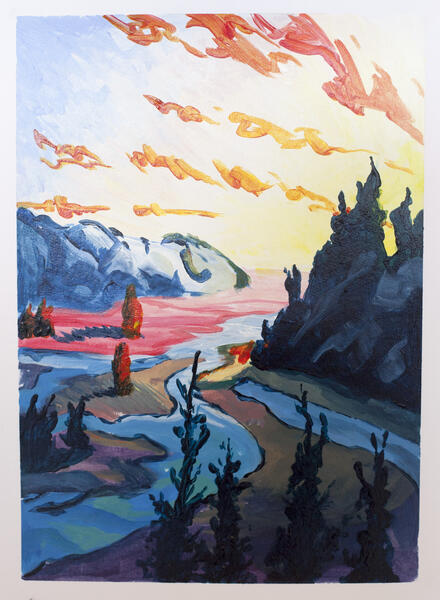 Free SpaceThe classes begin by introducing participants to a variety of art making techniques from drawing with charcoal, graphite, and pastels to painting with watercolor and acrylic. Once we would cover most techniques, the class would become a self-directed studio class with myself being able to offer individual support in each artist's work. This painting was created by Shiva at the Maryland Correctional Institution for Women. Because of the setting of the classes only the artist's first names can be used.
Free SpaceThe classes begin by introducing participants to a variety of art making techniques from drawing with charcoal, graphite, and pastels to painting with watercolor and acrylic. Once we would cover most techniques, the class would become a self-directed studio class with myself being able to offer individual support in each artist's work. This painting was created by Shiva at the Maryland Correctional Institution for Women. Because of the setting of the classes only the artist's first names can be used. -
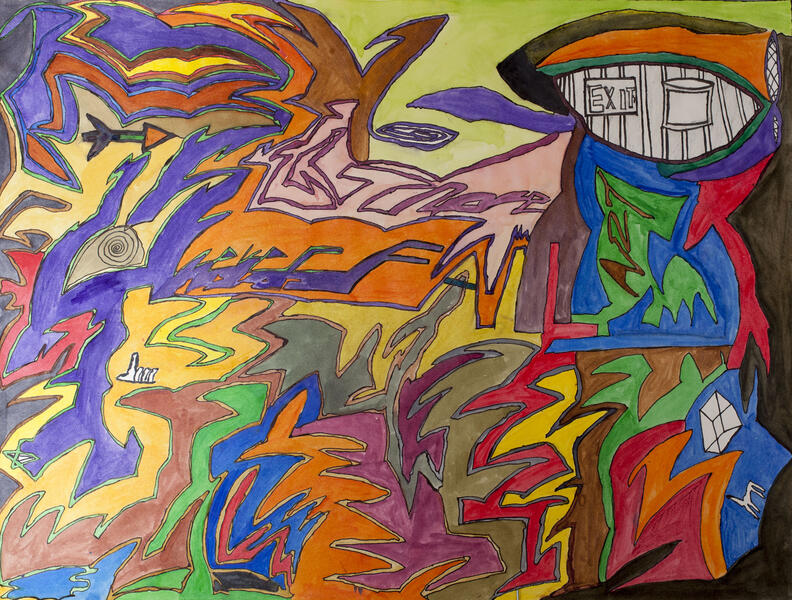 daveMay2016_152.jpgThe classes begin by introducing participants to a variety of art making techniques from drawing with charcoal, graphite, and pastels to painting with watercolor and acrylic. Once we would cover most techniques, the class would become a self-directed studio class with myself being able to offer individual support in each artist's work. This painting was created by Jeremiah at Dorsey Run Correctional Facility. Because of the setting of the classes only the artist's first names can be used.
daveMay2016_152.jpgThe classes begin by introducing participants to a variety of art making techniques from drawing with charcoal, graphite, and pastels to painting with watercolor and acrylic. Once we would cover most techniques, the class would become a self-directed studio class with myself being able to offer individual support in each artist's work. This painting was created by Jeremiah at Dorsey Run Correctional Facility. Because of the setting of the classes only the artist's first names can be used. -
 Free SpaceThe classes begin by introducing participants to a variety of art making techniques from drawing with charcoal, graphite, and pastels to painting with watercolor and acrylic. Once we would cover most techniques, the class would become a self-directed studio class with myself being able to offer individual support in each artist's work. This painting was created by Keonay at the Maryland Correctional Institution for Women. Because of the setting of the classes only the artist's first names can be used.
Free SpaceThe classes begin by introducing participants to a variety of art making techniques from drawing with charcoal, graphite, and pastels to painting with watercolor and acrylic. Once we would cover most techniques, the class would become a self-directed studio class with myself being able to offer individual support in each artist's work. This painting was created by Keonay at the Maryland Correctional Institution for Women. Because of the setting of the classes only the artist's first names can be used. -
 Free SpaceThe classes begin by introducing participants to a variety of art making techniques from drawing with charcoal, graphite, and pastels to painting with watercolor and acrylic. Once we would cover most techniques, the class would become a self-directed studio class with myself being able to offer individual support in each artist's work. This sculpture was created by Christian using toilet paper, soap, and acrylic paint at Dorsey Run Correctional Facility. Because of the setting of the classes only the artist's first names can be used.
Free SpaceThe classes begin by introducing participants to a variety of art making techniques from drawing with charcoal, graphite, and pastels to painting with watercolor and acrylic. Once we would cover most techniques, the class would become a self-directed studio class with myself being able to offer individual support in each artist's work. This sculpture was created by Christian using toilet paper, soap, and acrylic paint at Dorsey Run Correctional Facility. Because of the setting of the classes only the artist's first names can be used. -
 Free SpaceThe classes begin by introducing participants to a variety of art making techniques from drawing with charcoal, graphite, and pastels to painting with watercolor and acrylic. Once we would cover most techniques, the class would become a self-directed studio class with myself being able to offer individual support in each artist's work. This sculpture was created by Don using toilet paper, soap, and acrylic paint at Dorsey Run Correctional Facility. Because of the setting of the classes only the artist's first names can be used.
Free SpaceThe classes begin by introducing participants to a variety of art making techniques from drawing with charcoal, graphite, and pastels to painting with watercolor and acrylic. Once we would cover most techniques, the class would become a self-directed studio class with myself being able to offer individual support in each artist's work. This sculpture was created by Don using toilet paper, soap, and acrylic paint at Dorsey Run Correctional Facility. Because of the setting of the classes only the artist's first names can be used.
Free Space: Exhibitions and Murals
“Free Space” is a artist led program that creates a safe space for incarcerated individuals in the Maryland Prison system through art classes rooted in visual and written arts, stressing individual and collaborative growth while breaking down boundaries between the participants.
Since January 2015, Free Space has held programming at the Maryland Correctional Institution in Jessup weekly. In November of 2015, Free Space began programming at the Maryland Correctional Institution for Women as well as Dorsey Run Correctional Facility. Free Space utilizes artistic exercises, a historical and contemporary investigation into art, and arts based articles and essays to open the doors into the world of art for individuals participating in the program. In addition to weekly classes, Free Space creates publications and mounts exhibitions that bring the art work created by participants to the greater public. Complementing the weekly classes, the Visiting Artist program invites established artists to teach short workshops in an area of their expertise in the way that they see fit. The goal is to expose participants to as many different ideas and ways of making art as possible. Past visiting artists include Jordan Bernier, Peter Ferguson, and Lady Brion.
Free Space was founded by Dave Eassa in 2015.
Since January 2015, Free Space has held programming at the Maryland Correctional Institution in Jessup weekly. In November of 2015, Free Space began programming at the Maryland Correctional Institution for Women as well as Dorsey Run Correctional Facility. Free Space utilizes artistic exercises, a historical and contemporary investigation into art, and arts based articles and essays to open the doors into the world of art for individuals participating in the program. In addition to weekly classes, Free Space creates publications and mounts exhibitions that bring the art work created by participants to the greater public. Complementing the weekly classes, the Visiting Artist program invites established artists to teach short workshops in an area of their expertise in the way that they see fit. The goal is to expose participants to as many different ideas and ways of making art as possible. Past visiting artists include Jordan Bernier, Peter Ferguson, and Lady Brion.
Free Space was founded by Dave Eassa in 2015.
-
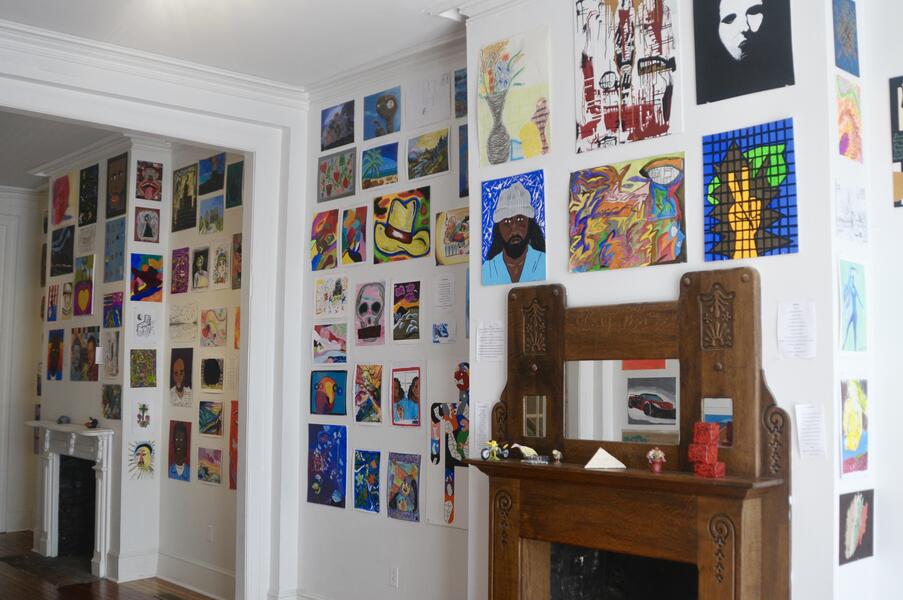 Free Space: "A Way Out"PLATFORM is proud to present a dual exhibition with works by Baltimore Youth Arts and Free Space in A WAY OUT. A WAY OUT celebrates the creativity and talent of the members of the Blank Page Project. THE BLANK PAGE PROJECTis an artist educator-led initiative that provides arts programming to youth and adults, with a focus on those involved in the juvenile and criminal justice systems. Our mission is to create opportunities, both within and outside of correctional institutions, which allow participants to gain creative, educational and personal skills. We believe that the arts are powerful tools for social change, personal discovery, and community building. They allow us to imagine and works towards a world that is free of oppression. Due to the distinct needs of participants, the Blank Page Project is comprised of two separate programs: Baltimore Youth Arts and Free Space. FREE SPACE, BPP’s adult program, operates within the following institutions: the Maryland Correctional Institution-Jessup, the Maryland Correctional Institution for Women and Dorsey Run Correctional Facility. Participants are given access to time, materials, and classes that foster self-expression and offer an alternative to prison culture. Weekly classes create a safe space for incarcerated individuals utilizing the visual and literary arts while encouraging individual and collaborative growth. Free Space also invites visiting artists to introduce participants to new creative skills in hopes of helping to prepare them for post-incarceration.
Free Space: "A Way Out"PLATFORM is proud to present a dual exhibition with works by Baltimore Youth Arts and Free Space in A WAY OUT. A WAY OUT celebrates the creativity and talent of the members of the Blank Page Project. THE BLANK PAGE PROJECTis an artist educator-led initiative that provides arts programming to youth and adults, with a focus on those involved in the juvenile and criminal justice systems. Our mission is to create opportunities, both within and outside of correctional institutions, which allow participants to gain creative, educational and personal skills. We believe that the arts are powerful tools for social change, personal discovery, and community building. They allow us to imagine and works towards a world that is free of oppression. Due to the distinct needs of participants, the Blank Page Project is comprised of two separate programs: Baltimore Youth Arts and Free Space. FREE SPACE, BPP’s adult program, operates within the following institutions: the Maryland Correctional Institution-Jessup, the Maryland Correctional Institution for Women and Dorsey Run Correctional Facility. Participants are given access to time, materials, and classes that foster self-expression and offer an alternative to prison culture. Weekly classes create a safe space for incarcerated individuals utilizing the visual and literary arts while encouraging individual and collaborative growth. Free Space also invites visiting artists to introduce participants to new creative skills in hopes of helping to prepare them for post-incarceration. -
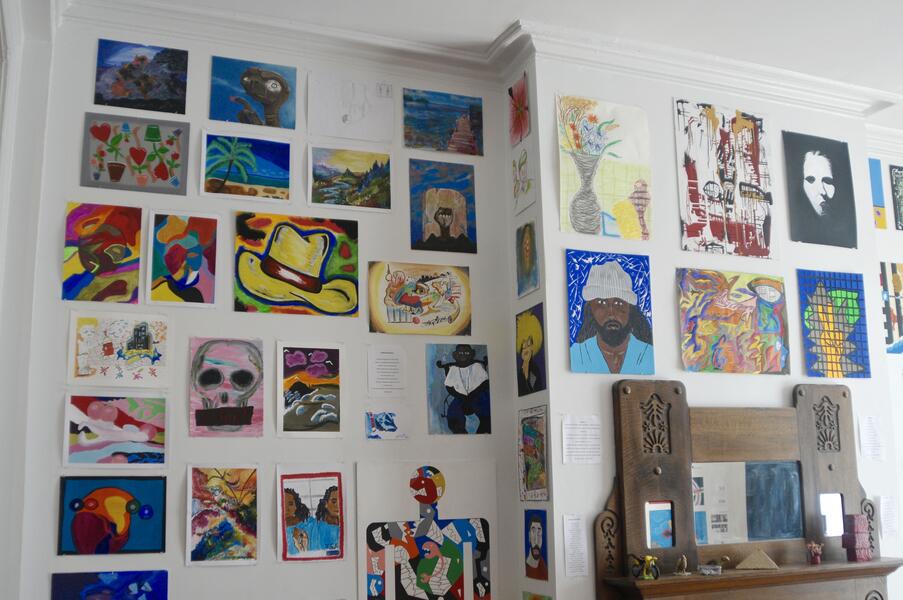 Free Space: "A Way Out"PLATFORM is proud to present a dual exhibition with works by Baltimore Youth Arts and Free Space in A WAY OUT. A WAY OUT celebrates the creativity and talent of the members of the Blank Page Project. THE BLANK PAGE PROJECTis an artist educator-led initiative that provides arts programming to youth and adults, with a focus on those involved in the juvenile and criminal justice systems. Our mission is to create opportunities, both within and outside of correctional institutions, which allow participants to gain creative, educational and personal skills. We believe that the arts are powerful tools for social change, personal discovery, and community building. They allow us to imagine and works towards a world that is free of oppression. Due to the distinct needs of participants, the Blank Page Project is comprised of two separate programs: Baltimore Youth Arts and Free Space. FREE SPACE, BPP’s adult program, operates within the following institutions: the Maryland Correctional Institution-Jessup, the Maryland Correctional Institution for Women and Dorsey Run Correctional Facility. Participants are given access to time, materials, and classes that foster self-expression and offer an alternative to prison culture. Weekly classes create a safe space for incarcerated individuals utilizing the visual and literary arts while encouraging individual and collaborative growth. Free Space also invites visiting artists to introduce participants to new creative skills in hopes of helping to prepare them for post-incarceration.
Free Space: "A Way Out"PLATFORM is proud to present a dual exhibition with works by Baltimore Youth Arts and Free Space in A WAY OUT. A WAY OUT celebrates the creativity and talent of the members of the Blank Page Project. THE BLANK PAGE PROJECTis an artist educator-led initiative that provides arts programming to youth and adults, with a focus on those involved in the juvenile and criminal justice systems. Our mission is to create opportunities, both within and outside of correctional institutions, which allow participants to gain creative, educational and personal skills. We believe that the arts are powerful tools for social change, personal discovery, and community building. They allow us to imagine and works towards a world that is free of oppression. Due to the distinct needs of participants, the Blank Page Project is comprised of two separate programs: Baltimore Youth Arts and Free Space. FREE SPACE, BPP’s adult program, operates within the following institutions: the Maryland Correctional Institution-Jessup, the Maryland Correctional Institution for Women and Dorsey Run Correctional Facility. Participants are given access to time, materials, and classes that foster self-expression and offer an alternative to prison culture. Weekly classes create a safe space for incarcerated individuals utilizing the visual and literary arts while encouraging individual and collaborative growth. Free Space also invites visiting artists to introduce participants to new creative skills in hopes of helping to prepare them for post-incarceration. -
Free Space: "A Way Out"PLATFORM is proud to present a dual exhibition with works by Baltimore Youth Arts and Free Space in A WAY OUT. A WAY OUT celebrates the creativity and talent of the members of the Blank Page Project. THE BLANK PAGE PROJECTis an artist educator-led initiative that provides arts programming to youth and adults, with a focus on those involved in the juvenile and criminal justice systems. Our mission is to create opportunities, both within and outside of correctional institutions, which allow participants to gain creative, educational and personal skills. We believe that the arts are powerful tools for social change, personal discovery, and community building. They allow us to imagine and works towards a world that is free of oppression. Due to the distinct needs of participants, the Blank Page Project is comprised of two separate programs: Baltimore Youth Arts and Free Space. FREE SPACE, BPP’s adult program, operates within the following institutions: the Maryland Correctional Institution-Jessup, the Maryland Correctional Institution for Women and Dorsey Run Correctional Facility. Participants are given access to time, materials, and classes that foster self-expression and offer an alternative to prison culture. Weekly classes create a safe space for incarcerated individuals utilizing the visual and literary arts while encouraging individual and collaborative growth. Free Space also invites visiting artists to introduce participants to new creative skills in hopes of helping to prepare them for post-incarceration.
-
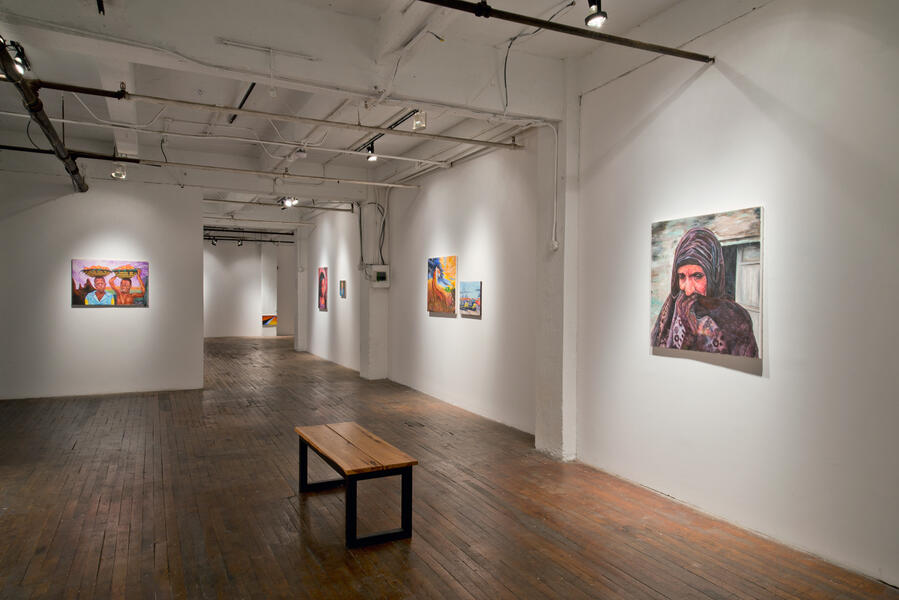 Shane McCallum: These EyesShane McCallum spent thirty seven years of his life exploring these questions. McCallum entered the Maryland prison system as a young man, still in his teenage years. He found himself in a place with the power to reduce a person to a number and crush aspirations. He turned to art as support and managed to hold on to his identity. Throughout his incarceration, McCallum experienced waves of artistic accessibility. At times, materials were provided by the institutions, but there were also years when he was cut off, unable to order paints or supplies. He constantly tried to use his talents to benefit everyone around him, to help uplift those struggling in the same situation. McCallum painted murals in the prison's visiting rooms to help children feel more at ease visiting their fathers, operated facepainting booths during Family Day, and painted portraits of loved ones to other incarcerated men. He donated is artwork to outside events to help benefit service organizations while also working on his own body of work. His paintings can be read like snippets of history seen through Time magazine. A lion behind bars depicts a struggle individuals in prison face daily, feeling powerless against a system designed to keep to keep them at bay. It is a system in which rehabilitation is no longer the goal and self worth is extinguished. A system that, all too often, locks the lion up and doesn't think twice. "Shane McCallum: These Eyes" was curated by Free Space at Gallery Four in Baltimore, MD and made possible with help from Kelley McCallum and Dave Eassa.
Shane McCallum: These EyesShane McCallum spent thirty seven years of his life exploring these questions. McCallum entered the Maryland prison system as a young man, still in his teenage years. He found himself in a place with the power to reduce a person to a number and crush aspirations. He turned to art as support and managed to hold on to his identity. Throughout his incarceration, McCallum experienced waves of artistic accessibility. At times, materials were provided by the institutions, but there were also years when he was cut off, unable to order paints or supplies. He constantly tried to use his talents to benefit everyone around him, to help uplift those struggling in the same situation. McCallum painted murals in the prison's visiting rooms to help children feel more at ease visiting their fathers, operated facepainting booths during Family Day, and painted portraits of loved ones to other incarcerated men. He donated is artwork to outside events to help benefit service organizations while also working on his own body of work. His paintings can be read like snippets of history seen through Time magazine. A lion behind bars depicts a struggle individuals in prison face daily, feeling powerless against a system designed to keep to keep them at bay. It is a system in which rehabilitation is no longer the goal and self worth is extinguished. A system that, all too often, locks the lion up and doesn't think twice. "Shane McCallum: These Eyes" was curated by Free Space at Gallery Four in Baltimore, MD and made possible with help from Kelley McCallum and Dave Eassa. -
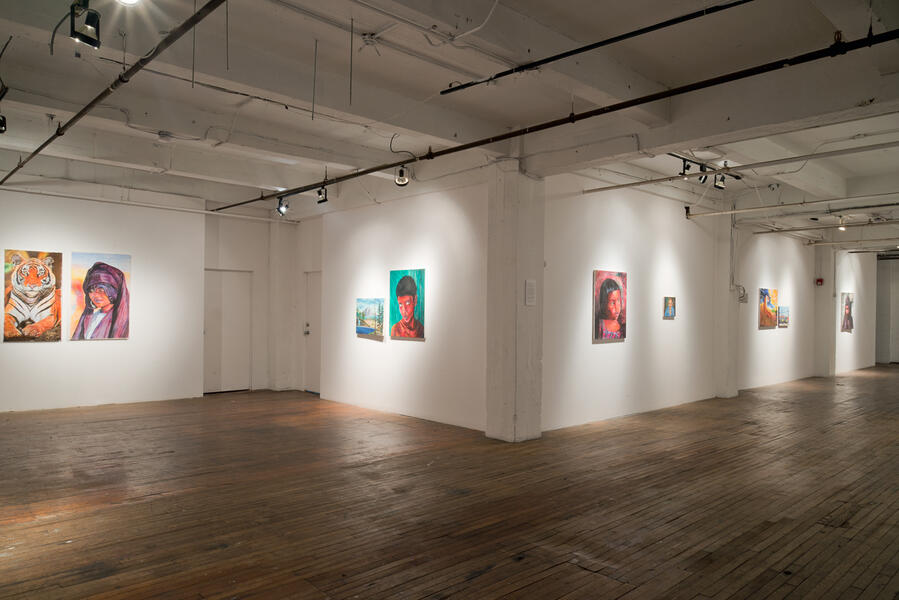 Shane McCallum: These EyesShane McCallum spent thirty seven years of his life exploring these questions. McCallum entered the Maryland prison system as a young man, still in his teenage years. He found himself in a place with the power to reduce a person to a number and crush aspirations. He turned to art as support and managed to hold on to his identity. Throughout his incarceration, McCallum experienced waves of artistic accessibility. At times, materials were provided by the institutions, but there were also years when he was cut off, unable to order paints or supplies. He constantly tried to use his talents to benefit everyone around him, to help uplift those struggling in the same situation. McCallum painted murals in the prison's visiting rooms to help children feel more at ease visiting their fathers, operated facepainting booths during Family Day, and painted portraits of loved ones to other incarcerated men. He donated is artwork to outside events to help benefit service organizations while also working on his own body of work. His paintings can be read like snippets of history seen through Time magazine. A lion behind bars depicts a struggle individuals in prison face daily, feeling powerless against a system designed to keep to keep them at bay. It is a system in which rehabilitation is no longer the goal and self worth is extinguished. A system that, all too often, locks the lion up and doesn't think twice. "Shane McCallum: These Eyes" was curated by Free Space at Gallery Four in Baltimore, MD and made possible with help from Kelley McCallum and Dave Eassa.
Shane McCallum: These EyesShane McCallum spent thirty seven years of his life exploring these questions. McCallum entered the Maryland prison system as a young man, still in his teenage years. He found himself in a place with the power to reduce a person to a number and crush aspirations. He turned to art as support and managed to hold on to his identity. Throughout his incarceration, McCallum experienced waves of artistic accessibility. At times, materials were provided by the institutions, but there were also years when he was cut off, unable to order paints or supplies. He constantly tried to use his talents to benefit everyone around him, to help uplift those struggling in the same situation. McCallum painted murals in the prison's visiting rooms to help children feel more at ease visiting their fathers, operated facepainting booths during Family Day, and painted portraits of loved ones to other incarcerated men. He donated is artwork to outside events to help benefit service organizations while also working on his own body of work. His paintings can be read like snippets of history seen through Time magazine. A lion behind bars depicts a struggle individuals in prison face daily, feeling powerless against a system designed to keep to keep them at bay. It is a system in which rehabilitation is no longer the goal and self worth is extinguished. A system that, all too often, locks the lion up and doesn't think twice. "Shane McCallum: These Eyes" was curated by Free Space at Gallery Four in Baltimore, MD and made possible with help from Kelley McCallum and Dave Eassa. -
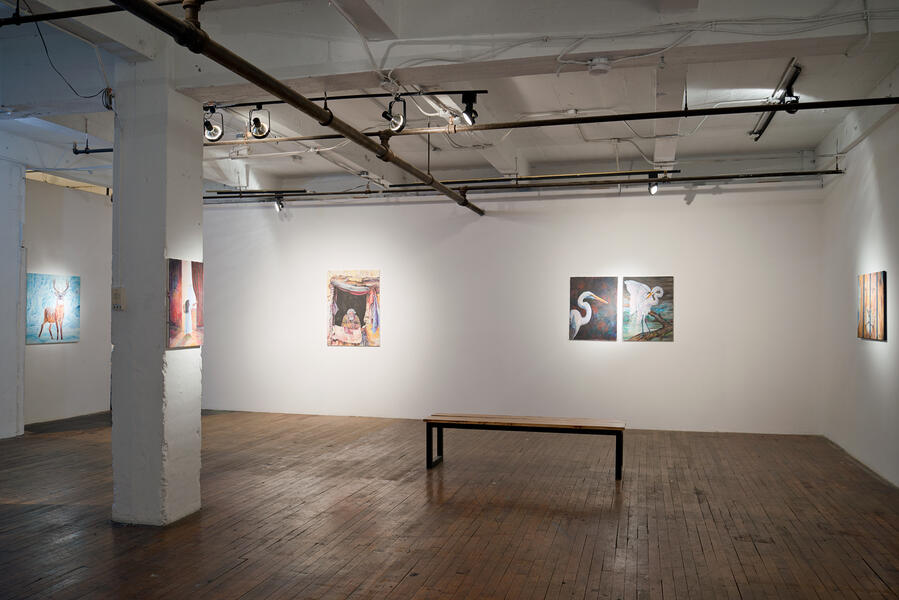 Shane McCallum: These EyesShane McCallum spent thirty seven years of his life exploring these questions. McCallum entered the Maryland prison system as a young man, still in his teenage years. He found himself in a place with the power to reduce a person to a number and crush aspirations. He turned to art as support and managed to hold on to his identity. Throughout his incarceration, McCallum experienced waves of artistic accessibility. At times, materials were provided by the institutions, but there were also years when he was cut off, unable to order paints or supplies. He constantly tried to use his talents to benefit everyone around him, to help uplift those struggling in the same situation. McCallum painted murals in the prison's visiting rooms to help children feel more at ease visiting their fathers, operated facepainting booths during Family Day, and painted portraits of loved ones to other incarcerated men. He donated is artwork to outside events to help benefit service organizations while also working on his own body of work. His paintings can be read like snippets of history seen through Time magazine. A lion behind bars depicts a struggle individuals in prison face daily, feeling powerless against a system designed to keep to keep them at bay. It is a system in which rehabilitation is no longer the goal and self worth is extinguished. A system that, all too often, locks the lion up and doesn't think twice. "Shane McCallum: These Eyes" was curated by Free Space at Gallery Four in Baltimore, MD and made possible with help from Kelley McCallum and Dave Eassa.
Shane McCallum: These EyesShane McCallum spent thirty seven years of his life exploring these questions. McCallum entered the Maryland prison system as a young man, still in his teenage years. He found himself in a place with the power to reduce a person to a number and crush aspirations. He turned to art as support and managed to hold on to his identity. Throughout his incarceration, McCallum experienced waves of artistic accessibility. At times, materials were provided by the institutions, but there were also years when he was cut off, unable to order paints or supplies. He constantly tried to use his talents to benefit everyone around him, to help uplift those struggling in the same situation. McCallum painted murals in the prison's visiting rooms to help children feel more at ease visiting their fathers, operated facepainting booths during Family Day, and painted portraits of loved ones to other incarcerated men. He donated is artwork to outside events to help benefit service organizations while also working on his own body of work. His paintings can be read like snippets of history seen through Time magazine. A lion behind bars depicts a struggle individuals in prison face daily, feeling powerless against a system designed to keep to keep them at bay. It is a system in which rehabilitation is no longer the goal and self worth is extinguished. A system that, all too often, locks the lion up and doesn't think twice. "Shane McCallum: These Eyes" was curated by Free Space at Gallery Four in Baltimore, MD and made possible with help from Kelley McCallum and Dave Eassa. -
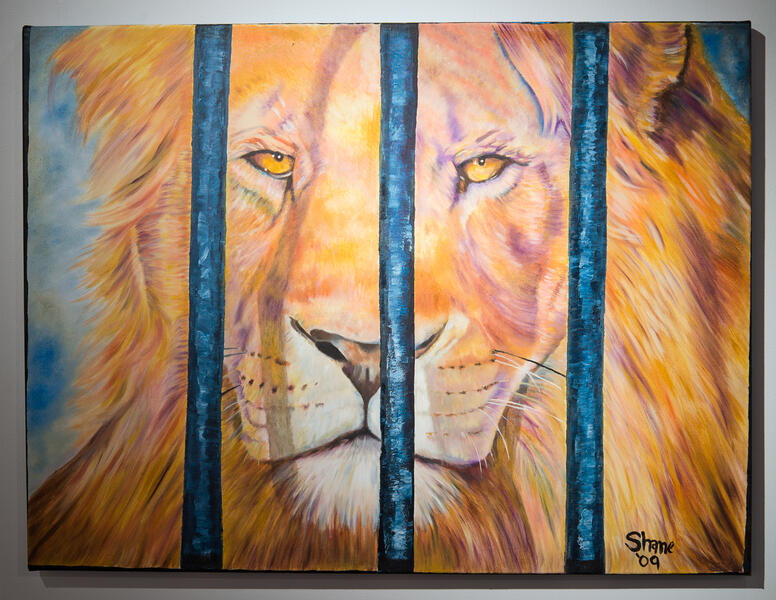 Shane McCallum: These EyesShane McCallum spent thirty seven years of his life exploring these questions. McCallum entered the Maryland prison system as a young man, still in his teenage years. He found himself in a place with the power to reduce a person to a number and crush aspirations. He turned to art as support and managed to hold on to his identity. Throughout his incarceration, McCallum experienced waves of artistic accessibility. At times, materials were provided by the institutions, but there were also years when he was cut off, unable to order paints or supplies. He constantly tried to use his talents to benefit everyone around him, to help uplift those struggling in the same situation. McCallum painted murals in the prison's visiting rooms to help children feel more at ease visiting their fathers, operated facepainting booths during Family Day, and painted portraits of loved ones to other incarcerated men. He donated is artwork to outside events to help benefit service organizations while also working on his own body of work. His paintings can be read like snippets of history seen through Time magazine. A lion behind bars depicts a struggle individuals in prison face daily, feeling powerless against a system designed to keep to keep them at bay. It is a system in which rehabilitation is no longer the goal and self worth is extinguished. A system that, all too often, locks the lion up and doesn't think twice. "Shane McCallum: These Eyes" was curated by Free Space at Gallery Four in Baltimore, MD and made possible with help from Kelley McCallum and Dave Eassa.
Shane McCallum: These EyesShane McCallum spent thirty seven years of his life exploring these questions. McCallum entered the Maryland prison system as a young man, still in his teenage years. He found himself in a place with the power to reduce a person to a number and crush aspirations. He turned to art as support and managed to hold on to his identity. Throughout his incarceration, McCallum experienced waves of artistic accessibility. At times, materials were provided by the institutions, but there were also years when he was cut off, unable to order paints or supplies. He constantly tried to use his talents to benefit everyone around him, to help uplift those struggling in the same situation. McCallum painted murals in the prison's visiting rooms to help children feel more at ease visiting their fathers, operated facepainting booths during Family Day, and painted portraits of loved ones to other incarcerated men. He donated is artwork to outside events to help benefit service organizations while also working on his own body of work. His paintings can be read like snippets of history seen through Time magazine. A lion behind bars depicts a struggle individuals in prison face daily, feeling powerless against a system designed to keep to keep them at bay. It is a system in which rehabilitation is no longer the goal and self worth is extinguished. A system that, all too often, locks the lion up and doesn't think twice. "Shane McCallum: These Eyes" was curated by Free Space at Gallery Four in Baltimore, MD and made possible with help from Kelley McCallum and Dave Eassa. -
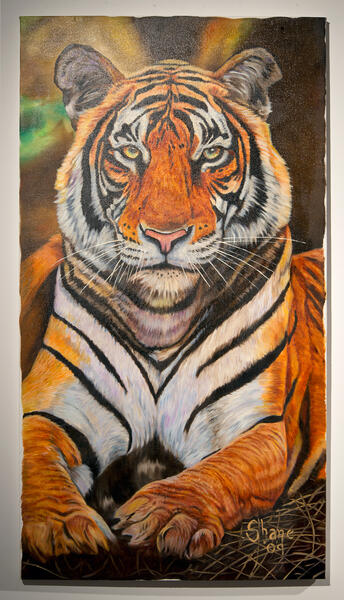 Shane McCallum: These EyesShane McCallum spent thirty seven years of his life exploring these questions. McCallum entered the Maryland prison system as a young man, still in his teenage years. He found himself in a place with the power to reduce a person to a number and crush aspirations. He turned to art as support and managed to hold on to his identity. Throughout his incarceration, McCallum experienced waves of artistic accessibility. At times, materials were provided by the institutions, but there were also years when he was cut off, unable to order paints or supplies. He constantly tried to use his talents to benefit everyone around him, to help uplift those struggling in the same situation. McCallum painted murals in the prison's visiting rooms to help children feel more at ease visiting their fathers, operated facepainting booths during Family Day, and painted portraits of loved ones to other incarcerated men. He donated is artwork to outside events to help benefit service organizations while also working on his own body of work. His paintings can be read like snippets of history seen through Time magazine. A lion behind bars depicts a struggle individuals in prison face daily, feeling powerless against a system designed to keep to keep them at bay. It is a system in which rehabilitation is no longer the goal and self worth is extinguished. A system that, all too often, locks the lion up and doesn't think twice. "Shane McCallum: These Eyes" was curated by Free Space at Gallery Four in Baltimore, MD and made possible with help from Kelley McCallum and Dave Eassa.
Shane McCallum: These EyesShane McCallum spent thirty seven years of his life exploring these questions. McCallum entered the Maryland prison system as a young man, still in his teenage years. He found himself in a place with the power to reduce a person to a number and crush aspirations. He turned to art as support and managed to hold on to his identity. Throughout his incarceration, McCallum experienced waves of artistic accessibility. At times, materials were provided by the institutions, but there were also years when he was cut off, unable to order paints or supplies. He constantly tried to use his talents to benefit everyone around him, to help uplift those struggling in the same situation. McCallum painted murals in the prison's visiting rooms to help children feel more at ease visiting their fathers, operated facepainting booths during Family Day, and painted portraits of loved ones to other incarcerated men. He donated is artwork to outside events to help benefit service organizations while also working on his own body of work. His paintings can be read like snippets of history seen through Time magazine. A lion behind bars depicts a struggle individuals in prison face daily, feeling powerless against a system designed to keep to keep them at bay. It is a system in which rehabilitation is no longer the goal and self worth is extinguished. A system that, all too often, locks the lion up and doesn't think twice. "Shane McCallum: These Eyes" was curated by Free Space at Gallery Four in Baltimore, MD and made possible with help from Kelley McCallum and Dave Eassa. -
Maryland Correctional Institution for Women MuralThe murals are located at the Maryland Correctional Institution for Women and were conceptualized, designed, and painted by a group of 10 women. The concept of the murals is a narrative that reflects and metaphors many of the women's journey through life and decisions that have brought them to their current situation. The mural is broken up into four main events: Chaos, Reality, Enlightenment, Happiness. These are general terms that can change with each individual but try to encapsulate everyone's thoughts. The characters pictured in the mural are all cartoon characters because the setting of the mural is the Visiting Room. The Visiting Room is a place where many of the women are reconnecting with their families, children, and loved ones and our goal was to brighten up the previously depressing cinderblock walls. It can be such a harrowing experience, especially for a young person, to have to enter the prison to see their mother and we wanted to make it more of a comfortable experience for any visitors entering the prison.
-
Maryland Correctional Institution for Women MuralThe murals are located at the Maryland Correctional Institution for Women and were conceptualized, designed, and painted by a group of 10 women. The concept of the murals is a narrative that reflects and metaphors many of the women's journey through life and decisions that have brought them to their current situation. The mural is broken up into four main events: Chaos, Reality, Enlightenment, Happiness. These are general terms that can change with each individual but try to encapsulate everyone's thoughts. The characters pictured in the mural are all cartoon characters because the setting of the mural is the Visiting Room. The Visiting Room is a place where many of the women are reconnecting with their families, children, and loved ones and our goal was to brighten up the previously depressing cinderblock walls. It can be such a harrowing experience, especially for a young person, to have to enter the prison to see their mother and we wanted to make it more of a comfortable experience for any visitors entering the prison.
The Road To Rio
The weekend warrior, rad dad, coach, or the weirdo down the street, everyone has one, everyone grew up around one. They exude passion, tenacity, excitement, some may even say they found the fountain of youth, not letting themselves be confined by the trials and tribulations of middle age and societal constructs. Regular things like the 9 to 5 lifestyle, parenting, office culture, or money issues that have the ability to turn most adults into shells of their former selves are taken in stride while they continue on. In the “Road to Rio”, Eassa creates a character that exists within a no frills olympic training facility through painted sculpture. It tells the story of Dad following what is considered to be the most elite sporting event in the world in his own way. In solidarity, the Dad has built his own renditions of traditional Olympic disciplines like the pole vault, track and field, shot putt, archery, and gymnastics in a way that utilized the materials from his immediate environment, suburbia. Utilizing empty Heineken mini kegs from the block parties as a shot putt, old plywood for his archery target, and over time as he fathered 5 children, he stole enough plastic balls from the McDonald’s playplace to fill a landing pit for the pole vault. The “Road to Rio” allows the Dad to train with the elite while praising and questioning the idea of mediocrity, individuality, the working class, patriarchy, elitism, amongst others. Eassa’s work consistently questions the societal constructs surrounding himself and others, exploring how he exists within these constructs, known or unknown, on his own terms.
-
 The Road to RioSolo exhibition with Platform Gallery at Little Berlin in Philadelphia, PA. March 2016. Pink Panther insulation foam, wood, sand, vinyl, spray paint, acrylic, and oil paint. Dimensions variable.
The Road to RioSolo exhibition with Platform Gallery at Little Berlin in Philadelphia, PA. March 2016. Pink Panther insulation foam, wood, sand, vinyl, spray paint, acrylic, and oil paint. Dimensions variable. -
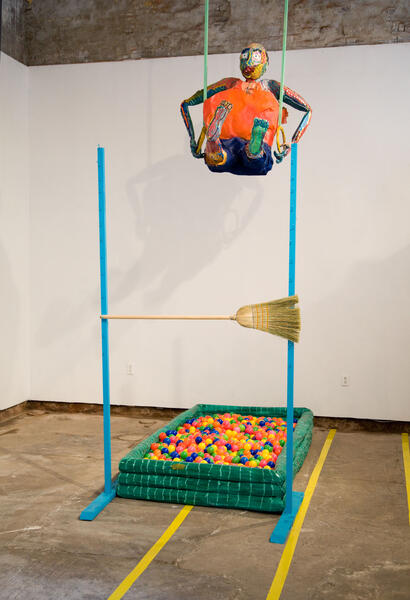 The Road to RioSolo exhibition with Platform Gallery at Little Berlin in Philadelphia, PA. March 2016. Pink Panther insulation foam, wood, sand, vinyl, spray paint, acrylic, and oil paint. Dimensions variable.
The Road to RioSolo exhibition with Platform Gallery at Little Berlin in Philadelphia, PA. March 2016. Pink Panther insulation foam, wood, sand, vinyl, spray paint, acrylic, and oil paint. Dimensions variable. -
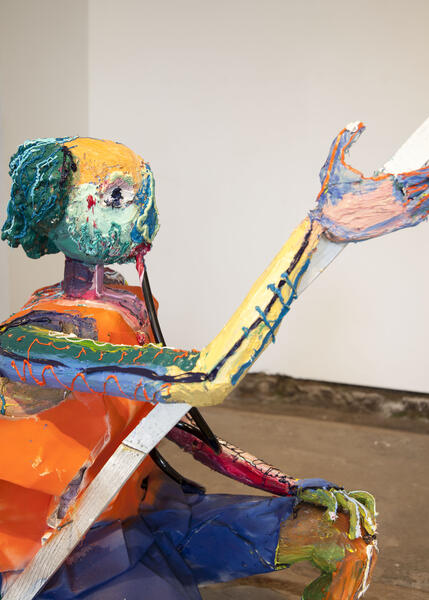 The Road to RioSolo exhibition with Platform Gallery at Little Berlin in Philadelphia, PA. March 2016. Pink Panther insulation foam, wood, sand, vinyl, spray paint, acrylic, and oil paint. Dimensions variable.
The Road to RioSolo exhibition with Platform Gallery at Little Berlin in Philadelphia, PA. March 2016. Pink Panther insulation foam, wood, sand, vinyl, spray paint, acrylic, and oil paint. Dimensions variable. -
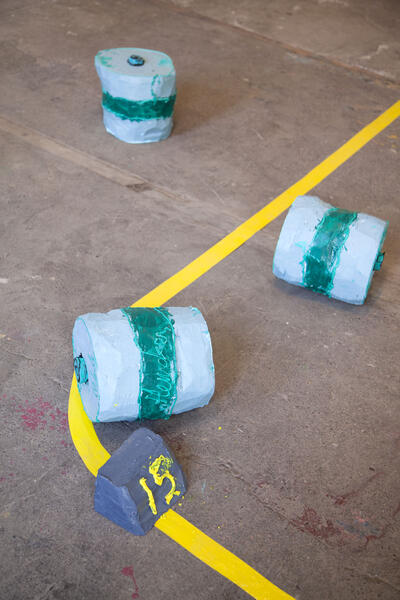 The Road to RioSolo exhibition with Platform Gallery at Little Berlin in Philadelphia, PA. March 2016. Pink Panther insulation foam, wood, sand, vinyl, spray paint, acrylic, and oil paint. Dimensions variable.
The Road to RioSolo exhibition with Platform Gallery at Little Berlin in Philadelphia, PA. March 2016. Pink Panther insulation foam, wood, sand, vinyl, spray paint, acrylic, and oil paint. Dimensions variable. -
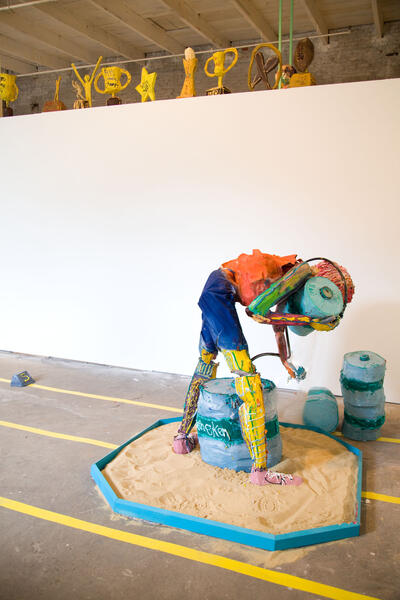 The Road to RioSolo exhibition with Platform Gallery at Little Berlin in Philadelphia, PA. March 2016. Pink Panther insulation foam, wood, sand, vinyl, spray paint, acrylic, and oil paint. Dimensions variable.
The Road to RioSolo exhibition with Platform Gallery at Little Berlin in Philadelphia, PA. March 2016. Pink Panther insulation foam, wood, sand, vinyl, spray paint, acrylic, and oil paint. Dimensions variable. -
 The Road to RioSolo exhibition with Platform Gallery at Little Berlin in Philadelphia, PA. March 2016. Pink Panther insulation foam, wood, sand, vinyl, spray paint, acrylic, and oil paint. Dimensions variable.
The Road to RioSolo exhibition with Platform Gallery at Little Berlin in Philadelphia, PA. March 2016. Pink Panther insulation foam, wood, sand, vinyl, spray paint, acrylic, and oil paint. Dimensions variable. -
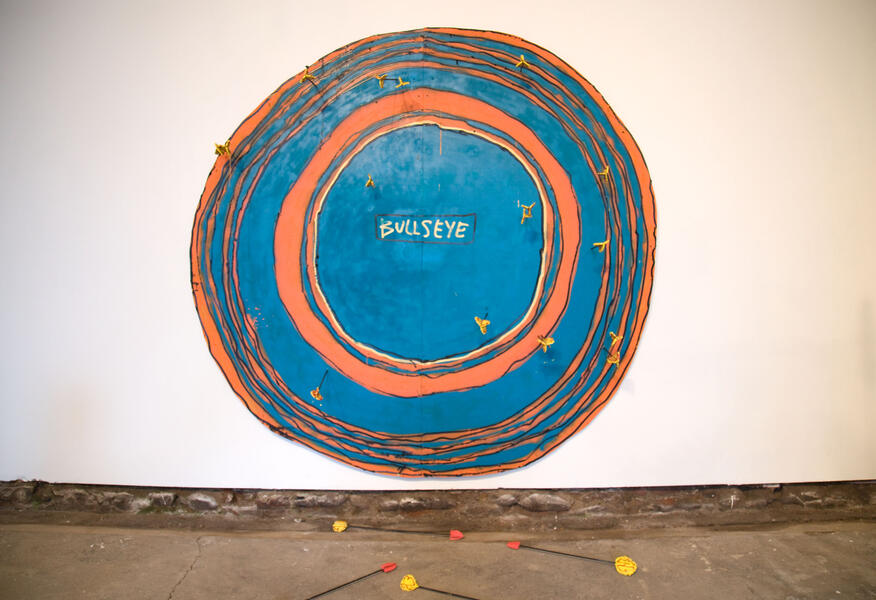 The Road to RioSolo exhibition with Platform Gallery at Little Berlin in Philadelphia, PA. March 2016. Pink Panther insulation foam, wood, sand, vinyl, spray paint, acrylic, and oil paint. Dimensions variable.
The Road to RioSolo exhibition with Platform Gallery at Little Berlin in Philadelphia, PA. March 2016. Pink Panther insulation foam, wood, sand, vinyl, spray paint, acrylic, and oil paint. Dimensions variable. -
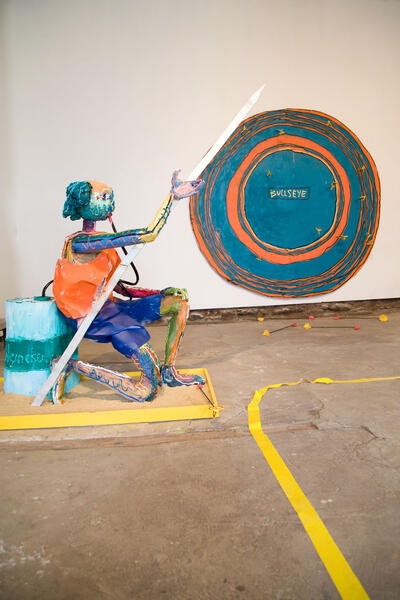 The Road to RioSolo exhibition with Platform Gallery at Little Berlin in Philadelphia, PA. March 2016. Pink Panther insulation foam, wood, sand, vinyl, spray paint, acrylic, and oil paint. Dimensions variable.
The Road to RioSolo exhibition with Platform Gallery at Little Berlin in Philadelphia, PA. March 2016. Pink Panther insulation foam, wood, sand, vinyl, spray paint, acrylic, and oil paint. Dimensions variable. -
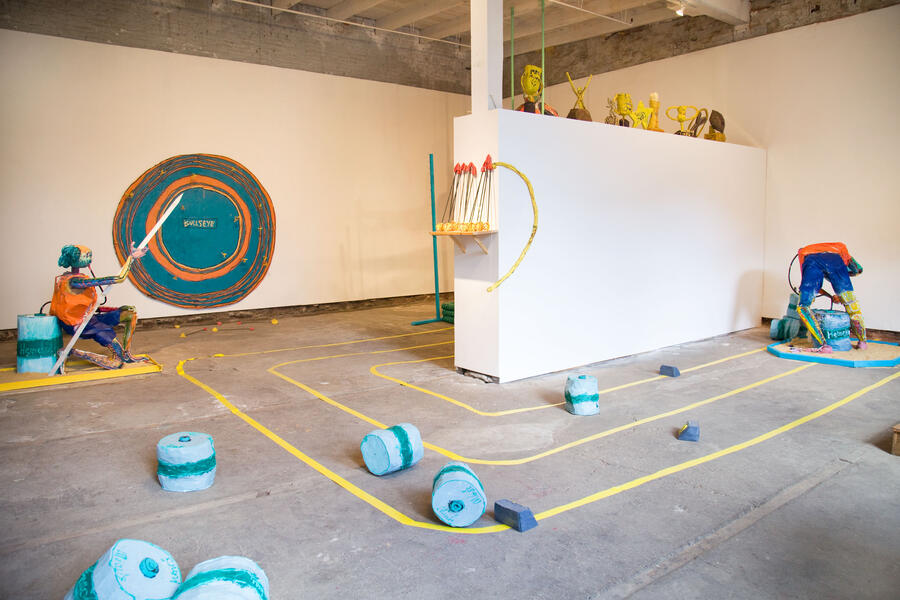 The Road to RioSolo exhibition with Platform Gallery at Little Berlin in Philadelphia, PA. March 2016. Pink Panther insulation foam, wood, sand, vinyl, spray paint, acrylic, and oil paint. Dimensions variable.
The Road to RioSolo exhibition with Platform Gallery at Little Berlin in Philadelphia, PA. March 2016. Pink Panther insulation foam, wood, sand, vinyl, spray paint, acrylic, and oil paint. Dimensions variable.















